ISSUE SEVENTEEN
AUTUMN/WINTER 2023-2024

CENTRED ON BALANCE ARCHITECTURE
NATURE
HOLISTIC HEALTH
Winter is a magical time
Discover on www.hotelnomad.ca our packages thermal experience in partnership with Strøm nordic spa - Old Quebec


Save the date
Nov. 23 - Dec. 23 Quebec city German Christmas market

Dec. 28-31 New Year’s celebration on Grande-Allée street
Feb. 02-11 Quebec Winter Carnival and ice canoe race
Mid-Feb. - Mid-Mar. Village Nordik - Port of Quebec
Feb. 17-25 Pentathlon des neiges
In 2023, Hotel Nomad has been certified Biosphere Sustainable lifestyle for hotels and carbon-neutral company (scope 1+2)

+1 (418) 694-1884 - www.hotelnomad.ca
Credit : Flore Tellier
Credit : Mélanie Jean Photographe
SAVE 20% ON SUBSCRIPTIONS WITH PROMO CODE STROM20



ARCHITECTURE DESIGN ART +
MAGAZINE MAGAZINELIGNE.CA


There’s always a special occasion Reserva de la Familia Brut Nature Available at the SAQ | 10654948 organic
In this issue
ARCHITECTURE
10 — 13
INSPIRATION
14 — 17
WORLD 18 — 21
SOCIETY 22 — 36
HOLISTIC HEALTH
42 — 51
WELL-BEING AT WORK
58 — 60
CULTURE
62 — 63
À TABLE 64 — 75
Guillaume Lemoine President
Emilie Lefebvre-Morasse
Vice-President of Marketing and Sales, Editor in Chief
Arianne Filion
Assistant Editor in Chief
Geneviève Dion Senior Director of Marketing and Sales
Myriam Dumont Marketing Director
Sarah-Maude Dalcourt
Production and Brand Director
On the Necessity of Sanctuary, by Hugues Lefebvre-Morasse
Art as Refuge: An Interview with Anaïs Barbeau-Lavalette
Sacred Journeys, by Franck Laboue
Known for Being Silent: An Interview with Olivier Niquet
The Language of the People of the North: An Interview with Daniel Chartier Without a Shadow of Regret: An Interview with Sister Lise Tanguay
Gua Sha: An Ancestral Technique Strøm Nordic Spa Saint-Sauveur: From a Private Home to a Large-Scale Spa
Recognition at Work: Creator of Natural Momentum, by Julie Tremblay-Potvin
Silence, by Joannie Roberge
Recipe: Savoury Smoked Salmon Cake, by Kevin Lafrenière
A Lesson from Italy, by Emiko Davies
The Trades of Wine, Continued, by Stéphanie Dupuy
Sarah Lamarche Artistic Director
Bianca Des Jardins Photographer
Catherine Gaudet Proofreader
Gaëlle Meslin Proofreader
Pierrette Brousseau Proofreader
SLRR Translation Firm Translation
Printing
Imprimerie Solisco Inc.
Advertising sales
Christine Mailloux, cmailloux@stromspa.com (514) 761-7900, ext. 4304
To collaborate on content
Arianne Filion, afilion@stromspa.com
Publisher
Strøm Nordic Spa 1001, boul. de la Forêt Nuns’ Island, Quebec H3E 1X9
Legal deposit — ISSN 2369-5897
National Library of Canada and Bibliothèque et Archives nationales du Québec. The opinions expressed in the articles of Strøm Magazine are the sole responsibility of the authors. The availabilities, vintages, and prices mentioned in the magazine are subject to change without notice. Any reproduction, in whole or in part, is prohibited without the permission of Strøm Nordic Spa. All rights reserved.
Publication mail — 42293512
STRØM MAGAZINE 5 THEMATIC FILES
Since the beginning, Strøm Magazine has had the immense privilege of collaborating with experts from all walks of life to write the articles that compose it. With great generosity, they offer us their knowledge and share their perspective—some from season to season, others more occasionally. It is with great pride that we invite you to discover them here.
STRØM MAGAZINE OUR CONTRIBUTORS
STÉPHANIE DUPUY Landing her first job at the SAQ really got her hooked! Several courses and 18 years in the wine industry later, Stéphanie loves drinking, sharing, and—above all—talking about wine! The sommelière has written for Strøm Magazine since 2008.
EMIKO DAVIES Emiko is an Australian-Japanese cookbook author who has won many awards. She lives in Tuscany with her husband and two children, where she offers cooking workshops.

FRANCK LABOUE A native of Brittany, Franck is eternally curious. A specialist advisor at Voyageurs du Monde, he ended up settling down in Quebec. He has written for the magazine for nearly five years.


KEVIN LAFRENIÈRE Kevin is the executive sous-chef of Strøm Nordic Spa restaurants, where local produce, seasonal ingredients, and Nordic-inspired flavours come together to give rise to a memorable culinary experience.
HUGUES LEFEBVRE-MORASSE
A Montreal designer, Hugues specializes in architecture and urban design. A faithful contributor to Strøm Nordic Spa, he has also written for the magazine for many years.

JOANNIE ROBERGE A philosophy and professional writing graduate, Joannie specialized in literary publishing before founding La Bonne Mine, a manuscript evaluation and writing workshop service.

JULIE TREMBLAY-POTVIN Passionate about people, organizations, and new models, Julie is the co-founder and president of De Saison — Art de vivre et de travailler.


Dear readers,
It is with great excitement that we have welcomed you since the beginning of autumn 2023 to our new facilities located near Saint-Sauveur. Five years after the opening of our spa in Old Quebec, we are proud to finally be able to welcome you to a fifth Strøm establishment.

This unveiling has a very special meaning for us, since we are setting up shop on the site of the first Nordic spa in Quebec. In 2022, we acquired the Polar Bear’s Club and Bagni Spa Station Santé, located on either side of the majestic Rivière à Simon, in the heart of the Laurentians. More than 60 years ago, on the site of the Polar Bear’s Club, the thermal cycle began to be practiced in Quebec, thanks to the proximity between the wood sauna that had been built there and the river. A few decades later, thermotherapy is still just as alive and loved there.
In keeping with our mission, we wish to develop these places of relaxation, which are already highly appreciated and recognized, to offer an even more comprehensive experience there. The construction of bridges linking the two sides of the river will allow visitors to enjoy an immersive thermal journey. The addition of services and experiences as well as our culinary offerings will also help enhance each guest’s moment of relaxation.
By carrying out this modernization, we wish to perpetuate Strøm’s values, but also honour tradition and celebrate the memory of those who introduced thermotherapy to Quebec for the first time. Because the proximity of the building and the river is an exceptional asset, we will take great care to highlight the natural surroundings out of respect for the history of the place. We are also delighted that the extraordinary team that has been in place until now will remain and become part of the big Strøm family.
45 minutes from Montreal, Strøm SaintSauveur, like our other establishments, is located near urban centres, yet in the heart of nature. Since the Laurentians is the third largest tourism region in Quebec, we hope that the establishment will serve both local customers and visitors from all over the country, and all over the world.
We now invite you to come discover (or rediscover) this place where nature and wellness are one, on the banks of the unforgettable Rivière à Simon.
 Guillaume Lemoine President
Photo: © Bianca Des Jardins
A WORD FROM THE PRESIDENT
Guillaume Lemoine President
Photo: © Bianca Des Jardins
A WORD FROM THE PRESIDENT
An Inner Pilgrimage
For generations, humanity has felt the visceral need to turn to places of reflection, introspection, and connection with the divine. From the sacred confines of churches to retreats in the heart of nature, from luxurious spas to meditation spaces, all have taken their place among our spiritual settings.
Over time, we’ve witnessed a social transformation through the subtle metamorphosis of the places where we gather. We’ve discovered that these places transcend cultures and aren’t limited to holy walls. Behind this clear (r)evolution hides a profound truth: the origin of our inner journey doesn’t lie in the place itself, but in ourselves.
Modern sanctuaries offer a backdrop, a context conducive to contemplation, the soothing of the restless mind, and connection with the self. They envelop us in calm and beauty, inviting us to slow down and refocus.
Sometimes, it’s enough to define a space, to synchronize with what surrounds us, to shift perspectives, and to adopt more often this state of mind specific to travel that speaks of openness, attention, wonder, and the present moment. This is a ritual that must be re-established to remind us to give our inner voice the time and attention it deserves. It’s an act of love toward ourselves, an attempt to understand our essence and our place in the world.
This issue is a rich and varied exploration of the theme of the search for balance featuring stories of churches, forests, art, silence, and healing that nourish the soul, body, and spirit.
With all our kindness,
Emilie Lefebvre-Morasse and the editorial team
“The true journey isn’t travelling through the desert or crossing great underwater distances; it’s arriving at an exceptional point where the flavour of the moment bathes all the contours of inner life.”
A WORD FROM THE EDITORIAL TEAM
– Antoine de Saint-Exupéry
On the Necessity of Sanctuary
By Hugues Lefebvre-Morasse, environmental designer
The relationship that Québécois society has with religion could not be more particular. The churches that stand proudly in our landscape bear witness to the spiritual fervour that once animated our communities. However, with the Quiet Revolution, Quebec underwent a major social transformation, and the old religious practices lost their hold on society, making way for a quest for new landmarks and an emergence of secular values. Today, we face a situation where many Catholic churches are threatened with demolition, their walls full of history testifying to the profound transition of a society. In this context, the necessity of sanctuaries becomes more important than ever, both to preserve our architectural heritage and to meet the spiritual needs of our time. What are today’s sacred spaces, what practices take place there, and what motivates people in search of new forms of spirituality?
As architectural historians Luc Noppen and Lucie K. Morisset put it so well, in Quebec, “our churches are our castles.” This quotation highlights the unique value of churches in the province. While in Europe, the architectural jewels are private residences, in Quebec, it is our churches—collective and community spaces—that bear this distinction. These places of contemplation, with their carefully designed architecture, play a crucial role in elevating the body, heart, soul, and spirit. They not only represent physical structures, but also places where history, spirituality, and community converge.
By exploring the importance of sanctuaries in our contemporary society, we highlight both old sanctuaries, which must reinvent themselves, and new sanctuaries, which offer renewed spiritual experiences. As we consider the future of our churches in Quebec, it becomes essential to find ways to transform these ancient sanctuaries into spaces that meet our current needs. Whether by creatively reusing existing structures or creating new buildings, it’s important to explore innovative possibilities for contemporary forms of spirituality.
10 STRØM MAGAZINE ARCHITECTURE
SPACES TO BE RECONSIDERED, VOCATIONS PRESERVED
In Quebec, our religious architectural heritage offers a building stock conducive to the reinvention of spirituality beyond traditional practices. These days, churches are finding new vocations that allow them to continue to play a crucial role in the life of the community. Their architecture, marked by symbolism and majesty, helps elevate our senses and connect us to deeper spiritual dimensions. Detached from religion, churches still offer spaces conducive to communion, meditation, reflection, and care, while being part of the line of service to the community.
A concrete example is the Théâtre Paradoxe in southwest Montreal. Managed by a cultural organization that also focuses on social reintegration, this sacred space has been reinvented to host events. With its large hall featuring impeccable acoustics, the theatre offers a group communion, where individuals can come together, share emotions, and experience a form of collective transcendence through music. This creative reuse of religious architecture maintains a community vocation and allows the soul to be nourished through art that has become spirituality.
Libraries are often said to be sanctuaries of knowledge and literature. This is especially true when they are set up in former churches. The Bibliothèque Monique-Corriveau in Quebec City and the Grey Nuns’ Chapel recovered by Concordia University in Montreal are significant examples of this. The places have been transformed into areas of serenity, offering visitors an environment conducive to intellectual work, reflection, and contemplation. The elegant lines and soothing spaces of the original architecture have been retained, creating spaces that nourish our being while preserving the silence and inherent tranquility of the place. Visitors can therefore find the peace and quiet necessary for their meditation.
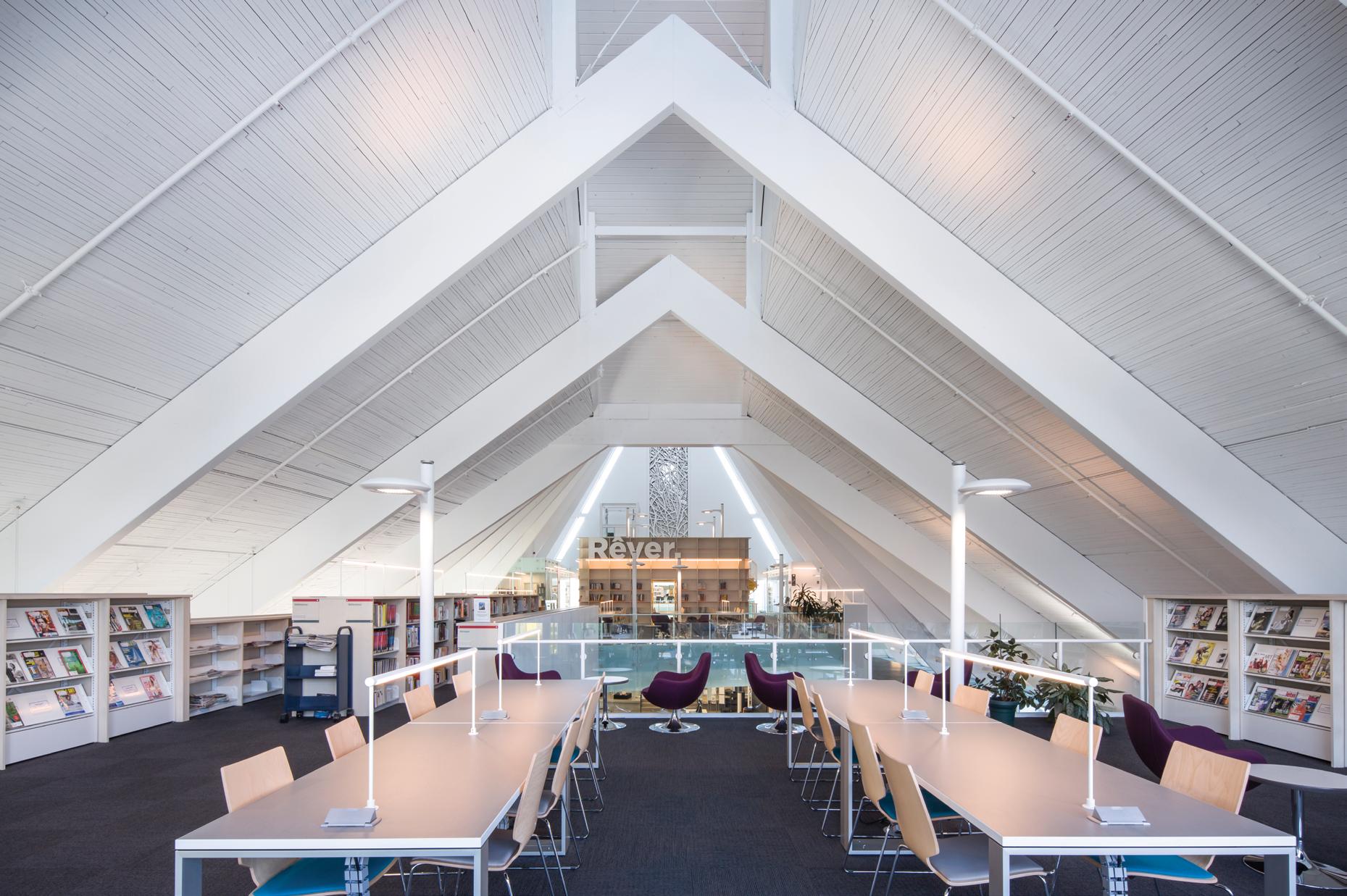
The Bibliothèque Monique-Corriveau in Quebec City
Photo: © Stéphane Groleau
STRØM MAGAZINE 11 ARCHITECTURE
Finally, Le Monastère des Augustines offers an inspiring example of the reuse of a convent as a place of care and wellbeing. Transformed into an accommodation establishment, it offers visitors a holistic experience of rejuvenation and introspection. The redesigned spaces, in harmony with the original architecture, offer environments conducive to relaxation and inner connection.
Communion through art, the serenity of silence, or healing retreats… These examples of reconversions testify to the richness and diversity of the possibilities offered by religious architecture in Quebec. They illustrate how places dedicated to spirituality can evolve to meet contemporary needs while preserving their sacred essence and offering renewed experiences to individuals in search of meaning.
NEW FORMS OF SPIRITUALITY
In addition to the transformation of former churches, we are also observing the creation of new types of sanctuaries that meet emerging spiritual needs. These reveal the importance of architecture and sacred places beyond religious dogmas. The UNESCO meditation space in Paris, designed by renowned architect Tadao Ando, is an evocative example of this trend. Its minimalist design creates a soothing atmosphere conducive to the elevation of the spirit and the search for inner peace. The sleek lines, subtle plays of light, and carefully selected materials encourage contemplation and invite individuals, regardless of their beliefs, to connect with their deep essence. This inclusive sacred space emphasizes the essential role that architecture plays in our quest for spirituality, transcending cultural and religious boundaries. It helps highlight the universal importance of sanctuaries, which can now take a multitude of forms.
RECLAIMING SANCTUARIES
Faced with the gradual disappearance of old religious practices and the need to renew our ways of practicing spirituality, it is crucial to recognize the importance of sanctuaries in our modern society. Despite our detachment from religion, spiritual spaces continue to play an essential role by providing places of introspection and connection to something greater than ourselves.
Sometimes, these places take surprising forms. While some prefer those imbued with majesty, such as our ancient churches, others also find this spiritual connection and comfort in nature. Spirituality can also live through the traditions and rituals that we practice with our loved ones, and the sanctuary then becomes the place where we simply take the time to truly be together.
In short, the preservation and creation of sanctuaries, whether old or new, religious or not, is not limited to an architectural matter, but extends to the valorization of their vocation and use. These are spaces that nourish us, connect us to a deeper dimension of our being, and strengthen the bonds that unite us as a community. By taking care of these sanctuaries and ensuring their evolution in harmony with our time, we preserve our cultural heritage while creating places where everyone can continue to develop spirituality and well-being.
12 STRØM MAGAZINE ARCHITECTURE
Spirituality can also live through the traditions and rituals that we practice with our loved ones, and the sanctuary then becomes the place where we simply take the time to truly be together.
 Le Monastère des Augustines in Quebec City
Le Monastère des Augustines in Quebec City
STRØM MAGAZINE 13 ARCHITECTURE
Photo: © Le Monastère des Augustines
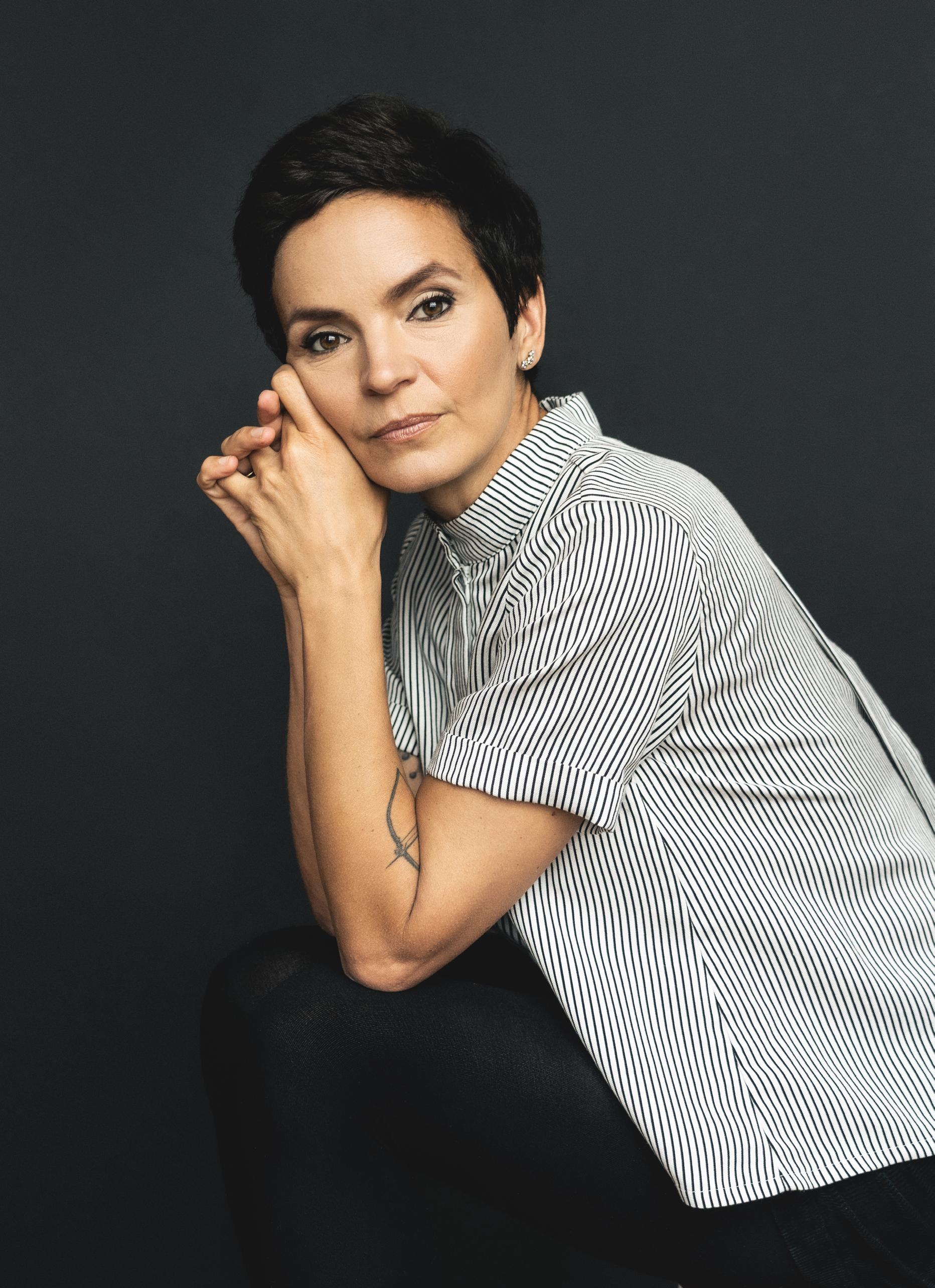 Photo: © Eva-Maude TC
Photo: © Eva-Maude TC
Art as Refuge
An Interview with Anaïs Barbeau-Lavalette
Anaïs Barbeau-Lavalette is a screenwriter, director, and novelist. Along with eco-sociologist Laure Waridel, she is also the co-founder of Mères au front, a movement that brings together mothers and grandmothers aimed at protecting the environment and the future of their children. Committed and inspiring, she shares with us the results of her reflection on her creative process and the place of transformative encounters.
Hello, Anaïs. What can you tell us about the role that stories play in your life?
“First of all, as a reader, fiction and essays have the effect of expanding me, making me broader. They reveal doors I have inside me, but which I wasn’t aware of until then. Some readings kick down a door or open other doors delicately, depending on the reading and the type of writer. There are pieces of me that had been dormant until then which are revealed by listening to certain voices. I love that. That also happens to me when I meet unique people, in the sense that encountering a work can easily be compared to meeting someone unique. These meetings can be remarkable, influencing the trajectory of my life, if I open myself up to them and allow myself to be porous.
“As an author, obviously, my work is born from a desire to tell a story. And whatever story I tell, I always choose my subjects carefully, because I know they’ll live inside me in a deep and lasting way. I don’t write a book a week—nor a screenplay, for that matter—so I think about my subjects knowing that we’ll live together for a long time.
“It’s always special to talk about the state of creation, because it’s so fragile and intimate. This is undoubtedly a very rare disposition, a quality of presence that is—again—very rare, very vulnerable. It requires an openness between yourself and your thoughts, defenseless, which doesn’t often happen in the ordinary world. On a daily basis, we’re rarely so directly connected to our essence. This is what makes writing so precious and special: the state of writing—especially literary—which is unlike almost anything else.”
STRØM MAGAZINE 15 INSPIRATION
ANAÏS BARBEAULAVALETTE
What, for you, are the essential elements for achieving this state of writing?
“It’s not something that can be forced. However, there are naturally favourable conditions. To write a novel… I make the distinction, because there’s something more mathematical and much less intimate about writing a screenplay. That doesn’t mean it’s easier to write, but let’s just say I don’t need the same introspection.
“So, to write a novel, normally, I need to isolate myself. I live life surrounded by people, I have three kids, my boyfriend is self-employed, and we don’t have a fixed schedule, so it’s necessary to find little pockets of time. I like to create writing residencies where I extract myself from my usual life, often in the country. I recently got into the habit of going to write near the river, because the St. Lawrence River inspires me, even if that’s not necessarily what I’m writing about. Its presence nourishes me a lot, in many ways.
“When I isolate myself, I don’t absolutely need to be alone; I can be surrounded by other people who have the same desire to create. What matters is silence, really just being alone with your thoughts. There can be ten people in the same house; everyone gets up early and starts creating while preserving their little bubble, then we meet up afterward to discuss.
“Nature is also essential to me, probably because I have a super lively urban life with lots of friends and lots of life around me. I think it’s a story of contrasts.”
In your novels, you often put forward opposing subjects: death that is part of life, the need to stay or go, the extraordinary in the ordinary. Do you do this deliberately?
“I like thinking about humanity at its extremes. I get the impression that often (and I’m including myself in this), we take a shortcut and paint ourselves with a single colour, when I think we’re much more complex than that. Our extremes are revealed in relation to what we encounter, so we have to allow ourselves to encounter subjects, languages, and works that shake us up and take us to one extreme or the other. It would be really boring to boil ourselves down to either sweetness or wildness. What’s magnificent about human beings is that we’re inhabited by all these extremes, and often, when we write, we’re pushed to think about all that. If I’m writing Femme forêt or Femme fleuve , I quickly realize that beauty isn’t just soft and soothing; it’s also tragic and violent. What I find extraordinary in early childhood is that it’s not just comforting, but brutal; this little emerging life brings me right back to death. All this makes me take a step back from the human condition, and I find it fascinating to look at it through all these spectrums.”
Freedom is another subject that dominates your stories. Would you say that among the jobs you do, one makes you feel freer than the others?
“Writing is the job where I feel freest. It’s peculiar, but I almost have an obligation for freedom in writing. That’s really been part of the fun since the beginning, even if I wrote things that could be difficult, such as in La femme qui fuit . [Note: This novel tells the story of Suzanne Meloche, her grandmother, who abandoned her children when they were very young.] I always try to have real pleasure when writing and real freedom to immerse my hands, yes, in reality, if reality inspires me, but to nourish myself totally and freely from my imagination and what life inspires me with. When you’re writing a book, it’s both the greatest risk, because there’s nothing to cover you and it’s just you and your words, but it’s also the greatest freedom.”
16 STRØM MAGAZINE INSPIRATION
You started writing novels later on in your career. How did that happen?
“I’ve been writing since I was very little. I’ve always loved writing, but really just for fun. My main job had always been, until very recently, a filmmaker. Lately, I say that I have two jobs, but I’ve only recently taken the second one up.
“It’s such a huge gift that people read me, that people are grateful for and pick up my words, that they understand me and follow me wherever I feel like taking them. There’s something overwhelming about that, because I need to write, so I would write even if people didn’t read me. But knowing that in addition, these words might resonate and register with readers, that they move certain things in them… The greatest and most moving testimonials I’ve received have been after books more than after films, although I also love my job as a filmmaker. In short, I feel like I’m still emerging as an author, while I’m in a more mature chapter—I would say—in my filmmaking career.”
How do you see the future?
“I need to do both, which is pretty magnificent. It wasn’t calculated, but the two feed off each other. After going through the huge storm of a film, which is a a big adventure, galvanizing, and charged, what helps me find myself again and make what I’ve achieved stick (because I think we’re transformed from one creative adventure to the next) is writing. Writing allows me that introspection, to meet myself again each time. It’s super healthy, and I really love that, so I think I’ll never stop either one. It’s an intimate, personal, and even creative balancing act. The walls I encounter in films later serve as lessons for me in writing, and vice versa.”
A DOURO WINE TO SHARE

INSPIRATION

Sacred Journeys
By Franck Laboue, Voyageurs du Monde
They called me “the beadle” in Beauce. I was a real church rat, a religious heritage enthusiast. Holy places have this invisible energy, this undefinable magnetism that draws me to them. However, like many people of my generation, I didn’t grow up with faith, with my baptism as the only baggage in my pocket. As churches close or undergo transformations, our relationship with the sacred is being shaken up. The heritage of our ancestors, their faith that moved mountains in the face of adversity… all that can be found in each of our churches. Perhaps it is toward them that our emotions are directed. Two millennia later, there’s a bit of us in every bell tower.
A DIFFERENT VISION OF HOLY PLACES

After leaving the granite churches of my native Brittany behind, I saw myself wandering with disbelief through the heated churches of Quebec—a paradox when I think back to the cold humidity of the sacred stones of Finistère. If our provincial religious heritage is looked at in the past, each trip abroad will involve this indescribable attraction to our shared foundation. Whether you’re devout, a believer, or simply secular, our getaways are sprinkled with prominent Christian places, most of them true architectural masterpieces.
Personally, I was moved in the old city of Jerusalem, walking the Via Dolorosa with strangers—the path that Jesus would have taken to his crucifixion. Arriving at the Holy Sepulchre, with centuries of devotion engraved on its walls, it was hard to remain indifferent to the electricity of the place. Perhaps it was the scent of incense that intoxicated me, or simply the symbolism of this site full of piety. I felt dizzy in Florence and Sienna, where beauty conquered my last defenses. Gaudi’s surrealism enchants and amazes every visitor to Barcelona, where the beauty of the sacred has been built over several centuries, demonstrating that the faith of humans is full of unsuspected resources. From the Gothic style of Cologne to the tropical modernism of the cathedrals of Rio de Janeiro, I’m an enchanted traveller: I always feel a little at home crossing the threshold of a church, as if an invisible umbilical cord linked us, it and me.
STRØM MAGAZINE 19 WORLD
Santa Maria del Fiore in Florence
Photo: © Sarah Lamarche
India and its architectural gems
Photo: © Bianca Des Jardins
ENCOUNTERING OTHER BELIEFS
Insatiably curious, the faith of others calls into question our own, as well as our spiritual void. Can we live without this piece of our soul in today’s world? We will question ourselves while sharing the Shabbat meal in the Jewish community, particularly in Israel. Beyond the religious symbolism, the Shabbat day is also the opportunity to rejoice as a family, empty your mind of material worries and considerations, immerse yourself in the study of the Torah, and welcome the well-being of Shabbat into your home.
Perhaps we will go and find a change of scenery in India—in Benares, or Varanasi, known for being one of the oldest cities in the world and one of the holiest places in Hinduism. Located on the banks of the Ganges, venerated for its pure waters, Benares leaves no traveller unmoved. Strolling through the city streets and along the Ghats, the traveller gets a concrete glimpse of the life of the pilgrims of Varanasi. We wander to Bengali Tola to visit the sanctuary of the mother goddess Kali, then to the riverbank toward Dashashwamedh, the city’s most famous Ghat where, according to Hindu myth, ten horses were sacrificed.
Finally, passing through Southeast Asia, we will go and make offerings at Tak Bat in Thailand. Tak Bat is a religious practice of profound generosity and a source of religious merit for faithful Buddhists. Practiced in the morning by Buddhists with fervour, concentration, and solemnity, this rite is probably the closest link between lay people and monks. In exchange for the food given to them, the bonze monks bless the faithful. At Ton Payom Market, the city’s largest market 10 minutes from the centre of Chiang Mai, the inhabitants bustle between the stalls to buy offerings intended for the monks. Cloaked in their saffron-coloured robes, the monks then begin their morning quest for the faithful.
THE VOYAGEURS DU MONDE ADDRESS: L’IGLESIA EL JADIDA
Within the Portuguese citadel of El Jadida, inside the ramparts, discover a charming hotel in a nineteenth-century Spanish church. Under the high vaulted ceilings of the nave, furniture from antique dealers in Marrakech combines with chandeliers, collections of old radios, hats, alarm clocks, mirrors, and bags and contributes to the personalized atmosphere of the lounge. Enjoy the view of the city from the terrace located at the foot of the bell tower. From the cloister, the view of the ocean and the port offers itself up to you. This hotel was designed by the owners of the Beldi Country Club, which already gives you the guarantee of a nice cocktail combining charm and authenticity.
VOYAGEURS DU MONDE FAVOURITE: HOLY WEEK IN SEVILLE
Recently, I found pious Seville on my path as a traveller. Baptismal clothing shops rubbed shoulders with ladies leaving centuries-old churches. In Seville, the tradition of Holy Week is very intense and has an absolutely unique spiritual and aesthetic dimension. For a week, the heart of the entire city beats to the rhythm of the processions. A crowd of tens of thousands of Sevillians and visitors, believers and non-believers, mingles with some fifteen hermandades to commemorate the death of Jesus Christ.
The members of these brotherhoods don their traditional costumes and cross the city from their respective churches to the cathedral via the carera oficial (official route). The processions involve two or three pasos—large platforms decorated with religious depictions— escorted by nazarenos, penitents dressed in tunics and masked with tall cone-shaped hoods.
The processions are accompanied by drums, trumpets, incense, and sometimes saetas —those moving flamenco songs sung a cappella by the Spaniards from their balconies to honour the brotherhoods. The fervour concludes with the resurrection of Christ. The costumes are put away, the chariots dismantled… but the respite is only short-lived. A few days later, the Feria de Abril opens—festivities, feasts, and flamenco: the very essence of Seville.
20 STRØM MAGAZINE WORLD




Enhance your relaxation with a stay in the heart of Montreal! hotelmonville.com
A cathedral in Seville, Spain
WORLD
Photo: © Sebastian Malecki

Known for Being Silent
An
Interview with
Olivier Niquet
Olivier Niquet is a radio commentator, co-host of the daily radio show La journée (est encore jeune) on ICI Première, author, and speaker. In April 2022, he published Les rois du silence, an essay aimed at helping introverts and extroverts understand each other better. Inspired by his journey as an introvert in the media as well as in everyday life, he wants to give a voice to the quietest among us.
Hello, Olivier. What are the reasons that motivated you to speak more openly about introversion in the media?
“Introverts, by definition, are pretty quiet. We don’t see them much, especially in the media. When I started talking about my introversion on the radio, I received messages from people who told me, ‘Thank you for talking about us. I’m also an introvert, and I feel recognized.’
“So, I realized there was an audience for that… I would say a market, but I didn’t write a book to make money (laughter) ! As a society, we often let extroverts speak. I wanted to give a voice to people who don’t talk.”
What is it about introversion that inhibits expression?
“There’s a question of neuropsychology behind this that I couldn’t explain in detail. But what’s certain is that we have to differentiate between embarrassment and introversion, because embarrassment is the fear of talking to people. I’m not necessarily afraid of talking to people. If I’m properly prepared, I’m capable of speaking in front of a room of hundreds of people without any problems. That doesn’t stress me out. But making small talk, talking about the rain and the nice weather... I can’t do that.”
Why?
“Often, I’d like discussions to be more meaningful, because it takes a lot of energy for me to have a discussion. Instead of staying on the surface and talking about the weather, I’d like to find a way to personalize the words. I’d like to say, ‘I saw your Instagram photo. Were you on a trip? How was it?’ But these references rarely come to mind for me in the moment… However, even if I’m not good at small talk, I recognize that it’s useful and important in society. It’s not threatening, there are no consequences to it, and we’re simply showing that we can be friendly.”
STRØM MAGAZINE 23 SOCIETY
OLIVIER NIQUET
How is your introversion received in a social context?
“I think it can be heavy, because I’d say I’m a pretty extreme case of introversion. I have trouble keeping a discussion going. When you’re talking to someone and they don’t restart the conversation or almost don’t respond, you may get the impression that they’re not interested, when that isn’t necessarily the case.
“My girlfriend, for example, in the early years of our relationship, must have found it difficult that I didn’t say a word all evening during a dinner with her friends whom I barely knew. But in all cases, I always show I’m interested in the discussion, even if I’m not participating in it very actively. I’m not in my corner with my phone; I’m not looking elsewhere. I’m actively listening, and people recognize that.
“So, while I totally accept my condition, I also try to improve myself so that it’s more pleasant for others. I do this over time without distorting myself.”
How do you get yourself there?
“One thing that helps a lot is figuring out how to distribute my energy on a daily basis. If I’m participating in a twohour brainstorming meeting at work, I’ll definitely leave it feeling drained. I won’t organize a party afterward; I know that in advance. I love parties, 5-à-7s... all that. I’m not a homebody, but I know that kind of event takes a lot of energy out of me, and I need to relax the next day.”
What is your relationship with silence?
“I like to be alone in silence. I find it valuable and important, among other reasons because that’s when I absorb and put together the knowledge I learned during the day. It’s when my best ideas for projects and subjects come up. However, these days, we’re almost never alone staring into the void. We’re on our phones, listening to music or a podcast, or watching TV. There’s always something we can take refuge in.
“Strangely, there are also times when silence makes me uncomfortable. For example, if I cross paths with someone I don’t really know while leaving the office, and we realize we’re both going to take the metro, and we have 10 minutes to walk together and not much to say to each other, that can quickly get uncomfortable. Even a short silence in an elevator can cause me discomfort, even though I appreciate silence, and I’m known for being silent!”
24 STRØM MAGAZINE SOCIETY
“My girlfriend, for example, in the early years of our relationship, must have found it difficult that I didn’t say a word all evening during a dinner with her friends [...]”
Do extroverts ever ask you to be more talkative?
“Ah, that’s the worst thing you can say to an introvert!
‘Why aren’t you talking?’ ‘Talk more!’ Personally, that puts pressure on me, and I talk even less. If I were capable and I wanted to talk more, I would do it! It’s beyond my control. This reasoning applies to all sorts of conditions. You can’t just tell someone with anxiety to calm down. It’s not something that can easily be controlled like that.
“We often see the same kind of situation with children. We ask them, ‘Why are you embarrassed? Why aren’t you talking? Say hello to the lady,’ and that often just adds to their stress.
“I have two kids, one of whom is a little more like me, and I don’t put any pressure on him. I see him go up to his hockey team, and he isn’t very similar to his teammates, and we laugh about it. He finds it funny, because he knows I was like that when I was younger (and still today). I don’t force him to go and talk to people and make friends; that’s not how it works. Just the fact that he understands that he’s like that is already a step in the right direction.”
Would you say that you have democratized introversion?
“I may have helped make it known, yes. But I think the important thing is accepting all types of personalities. I’m not asking for reasonable accommodations for introverted people, but maybe just making a little effort to recognize that they exist, and making room for them. And if they don’t want that room, that’s OK, too. But maybe they’re just waiting for someone to call on them to say what they have to say. It’s often happened to me that I have things to say, but I hesitate, or I’m incapable of inserting myself into the conversation. If someone had asked me, ‘What do you think about that?’, that would have helped.
“We live in a world where everyone is fighting for attention. It’s the one who shouts loudest and fastest who attracts attention, especially in the media and on social networks. While us introverts, we need to think before we decide. If there were a better balance and more room were given to those who think before speaking, perhaps things would be better in the world.”
To listen to the full interview, follow our podcast Centré sur l’équilibre
inspire every moment
handmade soy wax candles
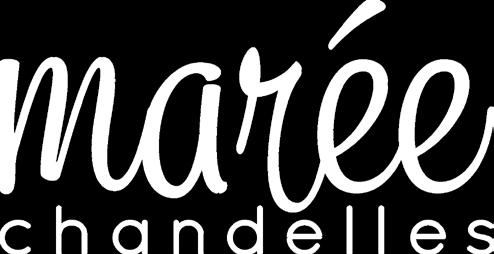

Proud partners of Strøm Nordic Spa www.mareechandelles.com
SOCIETY
 Photo: © Jp Valery
Photo: © Jp Valery
If silence is part of our landscapes and our seasons, it has also settled at the heart of our language.

The Language of the People of the North
An Interview with Daniel Chartier
Imagine winter. A big field in the countryside, covered with snow as far as the eye can see. A forest where every step is muffled by the reigning calm. The animals that hibernate or head south until the cold season is over. The city, asleep after a long storm. In all these images, a recurring theme: silence.
Since winter invites and calls for silence, it’s only natural that Daniel Chartier, a full professor at the Université du Québec à Montréal and the director of the Laboratoire international de recherche sur l’imaginaire du Nord, de l’hiver et de l’Arctique, was led to study it during his career. He notes, after years of being interested in the peoples of the North, that if silence is part of our landscapes and our seasons, it has also settled at the heart of our language.
So, is there a clear link between nature and silence?
“Definitely! And we’re lucky, because we live in a wintry environment where nature is accessible. We have an extraordinary tool at our fingertips to achieve silence. The forest, among other settings, is known for being a place that is both closed and open at the same time—an ecosystem that invades us, envelops us, and creates silence.
“Several writers also talk about nature as something we penetrate, and which changes us forever. I really like the writer Marie Le Franc, a Breton who settled in Quebec in the 1930s. Upon arrival, she immediately headed to the Laurentians, fascinated by the forest. She had the impression that the lake only had one function: producing silence. As if we could produce absence or emptiness through natural elements.”
Hello, Daniel. We think we know silence, but do we really know it?
“From a technical perspective, silence—true silence— would only be found in closed radio studios. It would be unbearable to live in such a complete absence of sound. We need resonance to find ourselves. Total silence would therefore be an objective and an illusion, because it’s pretty anxiety-inducing.
“However, what we call silence is an absence of violent sounds: the noise of machinery, something falling on the ground, a loud or disturbing repetitive sound. Silence can also be an excess of microsounds, like a river flowing through a forest, which is similar to silence. Several similar examples can be found in nature, such as the sound of a waterfall or the wind. We put these sounds in the category of what is quiet, even soothing. On the other hand, anything related to human intervention is often associated with noise.”
And what link do you make between culture and silence?
“Silence is a cultural construct, and it’s also a language between people. The choice not to speak, the need to be in silence. Silence affects who we are and our relationship with others, but also our relationship with the environment.
“Silence is sometimes spoken of as a weapon of the people of the North. Unlike the people of the South, we’re able to be much quieter, and that can create a destabilizing unease that ‘protects’ us, in a way. Being capable of not talking, providing simple answers, not immediately responding, tolerating silence in the presence of others… all this is specific to Nordic peoples.
“Silence is a richness of language, but it’s much subtler than speech. Culturally, we must be able to grasp its nuances, that the relationship we have with others lends itself to it, and that everyone values it.”
DANIEL CHARTIER
28 STRØM MAGAZINE SOCIETY
Photo: © Kristaps Grundsteins

Why is silence part of the language of the people of the North?
“There are several hypotheses. The passage of winter and the need for calm is one. Indeed, as we traditionally spend winter together in a house, we would go crazy if everyone had to speak all the time, at the same time. It would be a cacophony. You’ve surely felt it: after a weekend at a cottage with friends, we’re happy when Sunday arrives, and we can return to silence.
“The quality of silence established by winter can also become addictive, which means that we seek it out all year round, and that silence settles into our language. Snow is an insulator against cold, but also against sound. When you go outside after a snowstorm, even in the city, you get the feeling that it’s very quiet, but there are simply dozens of centimetres of insulation on the ground that absorb sound.
“Among the Scandinavians, there’s also an ethic of walking in the forest. You never talk or raise your voice. To them, the forest is as sacred as a church. You enter, and a solemnity sets in. Someone who talks while skiing won’t have understood anything. They can’t control themselves. That’s another aspect: self-control. This is a value that many peoples of the North consider important, and which involves the ability to speak with moderation, when it’s appropriate to do so.
“Among other peoples, such as the Finns, saying something that others have already said in a conversation is considered poor form. This gives rise to somewhat limited, almost oppressive conversations. Here, we pick up other people’s ideas; there’s more freedom. We’re a Nordic-Latin people, so yes, we like silence, but we also like to talk!”
“Being capable of not talking, providing simple answers, not immediately responding, tolerating silence in the presence of others… all this is specific to Nordic peoples.”
30 STRØM MAGAZINE SOCIETY
What are the benefits of silence on the body, and on well-being in general?



“First, one thing is certain: repetitive noise is violent for the body. This has been proven. For example, if there’s a railway near you and you constantly hear trains going by, you’ll end up forgetting the sound, but the body will continue to feel it and react to it in a negative way. Ideally, therefore, we would live in a quieter world.


“Then, as human beings, we need moments of contemplation and calm. These days, spas are one of the places we can go to meditate, and at one time, this was done at churches instead. In my opinion, there’s always a link between the body, silence, and peace of mind. These aren’t three independent concepts. Their codependency also appears after a ski day, for example. The solace that can be observed is related at once to the physical exertion, to the calm felt, to the cold and the heat, and to the body, which has thought of something else.”

In a daily life full of stimuli, have we lost sight of the importance of silence?
“It’s true that our attention is very strained these days, sometimes even in silence. A phone can annoy us in ways other than its ringtone. The amount of information to which we have access and the perpetual sorting that we have to do to select and retain the most relevant information create fatigue in the body and mind. If we could expose ourselves to fewer stimuli, at least at certain times, that would do the greatest good.
“When there’s too much talking or too much information, we no longer distinguish what’s around us. We have the impression that very simple things are becoming serious, and that’s where we lose our judgement. Without emptiness, things take on a great deal of importance, whereas on the contrary, they no longer have any. Silence allows us to clear our minds.”
To listen to the full interview, follow our podcast Centré sur l’équilibre



Essential oils and aromatherapy for body & soul
VIVIA, made in Quebec with organic essential oils. For stress, insomnia, colds, pain and more, visit aromavivia.com and find the right product for you. aromavivia.com
VIVIA, also manufacturer of Strøm Nordic Spa wellness products.
SOCIETY
 Strøm Nordic Spa Sherbrooke
Photo: © Adrien Williams
Strøm Nordic Spa Sherbrooke
Photo: © Adrien Williams
“Without emptiness, things take on a great deal of importance, whereas on the contrary, they no longer have any. Silence allows us to clear our minds.”


Without a Shadow of Regret
An Interview with Sister Lise Tanguay
Sister Lise Tanguay has devoted her life to helping sick people. Nearly 60 years ago, she joined the Augustines, a religious community that laid the foundations for the provision and administration of healthcare in Quebec.1 She recounts the past with emotion and gratitude and offers us, clearly and optimistically, her wishes for the future.
Hello, Sister Lise. Thank you for welcoming us to Le Monastère des Augustines, which is now a non-denominational place of accommodation open to the public, but also your home. How long have you lived here?
“I arrived in 1965. I did my nursing studies from 1961 to 1964, then I taught for a year at the nursing school. The nun who was in charge at the Hôtel-Dieu de SaintGeorges left to do her master’s degree in the United States and asked me to replace her. That changed my plans, because I wanted to enter the community, but she told me that if I really had the calling, I would also have it the following year (laughter). This allowed me to gain a great year of experience and live in an apartment.
“Then, I entered the community, took the three-year training, and started working at the Hôtel-Dieu in 1968. I have very good memories of this; we formed a beautiful family as a healthcare team. Eventually, I also specialized in psychiatry, because the field really interested me.”
So, before becoming a nun, you lived life as a young woman in Quebec City?
“Yes, and I had a great childhood. I had a great group of friends; we liked to go skating and dancing. We met up on weekends; it was nice. I even had a boyfriend at one point. But the calling was stronger.”
How did you feel this calling?
“I was very young, seeing my mother take care of sick people, when I felt it, and around age 12 or 13, I knew I would become a nun. I wanted to give my life for sick people. It’s hard to describe, but I felt it inside. It’s mysterious, the calling. It’s like love: when we decide to share our life with someone in particular, why do we choose that person and not someone else? It’s a beautiful mystery!”
Source
1 Ministère de la Culture et des Communications du Québec. (2013). Arrivée des Augustines en Nouvelle-France . https://www.patrimoine-culturel.gouv.qc.ca/rpcq/detail.do?methode=consulter&id=26548&type=pge
SISTER LISE TANGUAY
STRØM MAGAZINE 35 SOCIETY
Sister Lise Tanguay in a room before the renovation, ca. 2012, Le Monastère des Augustines
The nursing profession, especially since the pandemic, is going through hard times. Nurses are overworked, their working conditions are deteriorating, and many are leaving the healthcare system despite increasingly pressing needs. How do you see all that?
“The healthcare system isn’t really easy for these young people to live with. In the 1980s, all the experienced nurses retired, and that’s when the system started to break. We can’t replace people who have extensive experience in the care field overnight with people who are just starting out in the profession, even if they’re full of goodwill. It was necessary to take advantage of the experience of the old ones and continue the transmission. But we ended it too quickly, and we’ve never recovered from the impact of that decision.

“However, I was hospitalized two years ago, and I have to say that I found the care impeccable. The staff was really good, even if everyone was overloaded. I was also able to benefit from new care techniques and technologies, which are extraordinary. We shouldn’t shun progress, but today’s nurses need to be very skilled and alert to be able to follow all that.”
What does it mean, to you who have been a nurse, to “take care?”
“First, it’s about being attentive to the person you’re with. It’s considering them not only through the care they have to receive, but as a whole. You’re taking care of the person physically, yes, but also psychologically. They may be experiencing stress and anxiety. They probably have family or friends around them, but maybe not either. You can’t just consider the illness or the person you see on the outside; it’s much deeper than that, and it’s so beautiful when you get to know people. Needs are also different from one person to the next.”
Do you have any regrets about the life you’ve chosen? Do you feel like you’ve missed out on anything?
“I’ve never regretted anything. And it’s not like it’s always been rosy! There are problems everywhere. Community life consists of women who live together but didn’t choose each other and didn’t receive the same education, so naturally, there were more difficult moments. And of course, around age 30, I asked myself questions. I told myself, ‘if I continue down this path, but I leave the community in a few years, it will be too late to have children.’ I dreamed a few times of rocking the child while saying my prayers. That wouldn’t necessarily have been incompatible, but in the context of a life of devotion, it was impossible, so I had to make a choice. It’s normal, as a woman, to ask yourself questions at certain points in your life. But fundamentally, these questions never made me doubt my choice, and I was very happy.”
What would you like to leave behind?
“Generally speaking, I’d like people to give themselves the tools to live a balanced life that suits them and a life where they have time to be together. I was very moved, during the pandemic, by the testimonials of those who rediscovered their families and the meals shared together. That’s what I’d like: for people to rediscover themselves and live together for real, to give time to the essential things, to sharing and rest. Yes, work is important, but to the detriment of people and families? It’s essential to take the time to talk to each other; you don’t just have to watch TV and be on your cell phone.”
Do you have one? A cell phone?
“Ah, of course, I have one, and I wouldn’t want to do without it (laughter) ! We can use anything, but we have to use it wisely. We would be unhappy if technology disappeared! But moderation is always in good taste.”
To listen to the full interview, follow our podcast Centré sur l’équilibre


36 STRØM MAGAZINE SOCIETY







tnm.qc.ca SUBSCRIPTION + TICKETS Treat yourself! IN PARTNERSHIP WITH
Close your eyes. Open your senses.




H71 and Strøm Nordic Spa invite you to let it all go. Calm and relaxation await you in the heart of the Old Port of Quebec. Discover our packages. hotel71.ca
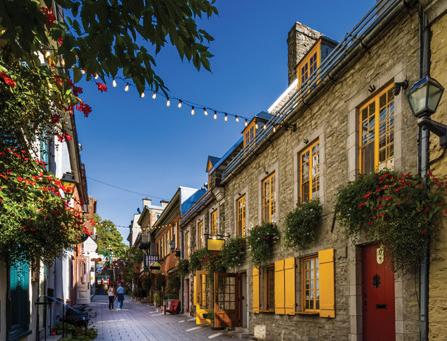





Relaxation Guaranteed
SecuriGlobe is Canada’s largest travel insurance broker. Travel insurance has been our specialty and unique expertise for over 2 decades. Take a well-deserved break and travel with peace of mind thanks to our comprehensive range of travel insurance products.

securiglobe.com 1 888 777-4904 Firm in the insurance of persons
The Subtleties of Tea, Reinvented with Passion
FROM MARTIAL ARTS TO THE TEA RITUAL
It all began in 2013, when Jonathan Cloutier spent nine months in China perfecting his martial arts practice. It was there, in the small town of Muping, in an ancestral tea room and in contact with its owner, Zhang Wei, that he discovered a love for tea and its universe, the subtleties of its taste, and the ritual that surrounds it.
Upon returning to Quebec, Jonathan continued to take an interest in tea. He stocked up at Camellia Sinensis, where he found the quality that had charmed him so much in China. In 2016, when kombucha was enjoying its moment of glory in the West, Jonathan decided to combine his interest in tea with his desire for entrepreneurship. He then launched Lao with two associates: Kim Décary and Philippe Boivin. The trio sold its very first bottle of kombucha in 2017.
UNIQUE KOMBUCHAS
Ever since, Lao has offered unique kombuchas with a balanced taste, made from high-quality tea and simple, natural ingredients. Coming from different parts of the world, the teas are fermented, thereby allowing each bottle to contain a wide variety of micronutrients beneficial to health. But one drinks Lao for its taste, first and foremost, which is why five taste profiles, inspired by the universe of sommellerie, have been designed to facilitate the consumer’s choice: floral, aromatic, rustic, herbaceous, and fruity. These profiles, indicated on the packaging, offer a preview of the flavours contained in each bottle.

LIKE AT THE VINEYARD
Over time, Jonathan, Kim, and Philippe realized that working with tea and producing kombucha is similar in several respects to the work of the winemaker and wine production. Indeed, tea and wine are two millennia-old beverages whose development is an art, whose often-artisanal production process is passed down from generation to generation, and whose tasting is practiced as a convivial ritual.
These similarities gave the team the idea of creating an alcohol-free sparkling tea-based drink. Lao therefore undertook a bold journey to rethink the experience of alcohol-free sparkling beverages. It was Gyokuro Okabe, a green shade tea from Japan, that was selected to develop the first sparkling tea. The variety of the leaves, the subtle blends, and the natural fermentation methods are an inexhaustible source of inspiration and make it possible to create a range of flavours just as complex and intriguing as those of the best wines.
By offering a healthy and delicious option that can replace traditional sparkling wine, Lao preserves the festive and unifying character of wine while honouring the evolution of consumption preferences, for both aperitifs and meals. Our sparkling tea offers a truly refined experience, worthy of the greatest tea rituals and the most special occasions. A new flavour will also be revealed in autumn 2023.
Visit laoinc.ca to discover our sparkling tea and enjoy a 10% discount on your order with code STROM10
Lao is a story of discovery, innovation, and quality—the result of the efforts of three passionate friends who want to revolutionize the world of ready-to-drink.
40 STRØM MAGAZINE EDITORIAL PARTNERSHIP
In the context of a partnership with Strøm, Lao has also developed an exclusive kombucha flavour: Boreal Tonic, made from Wulong Jin Shuan tea, balsam fir, juniper berries, and dune pepper. A collaboration between Asia and Quebec with a unique taste. Discover it at Nord restaurants.
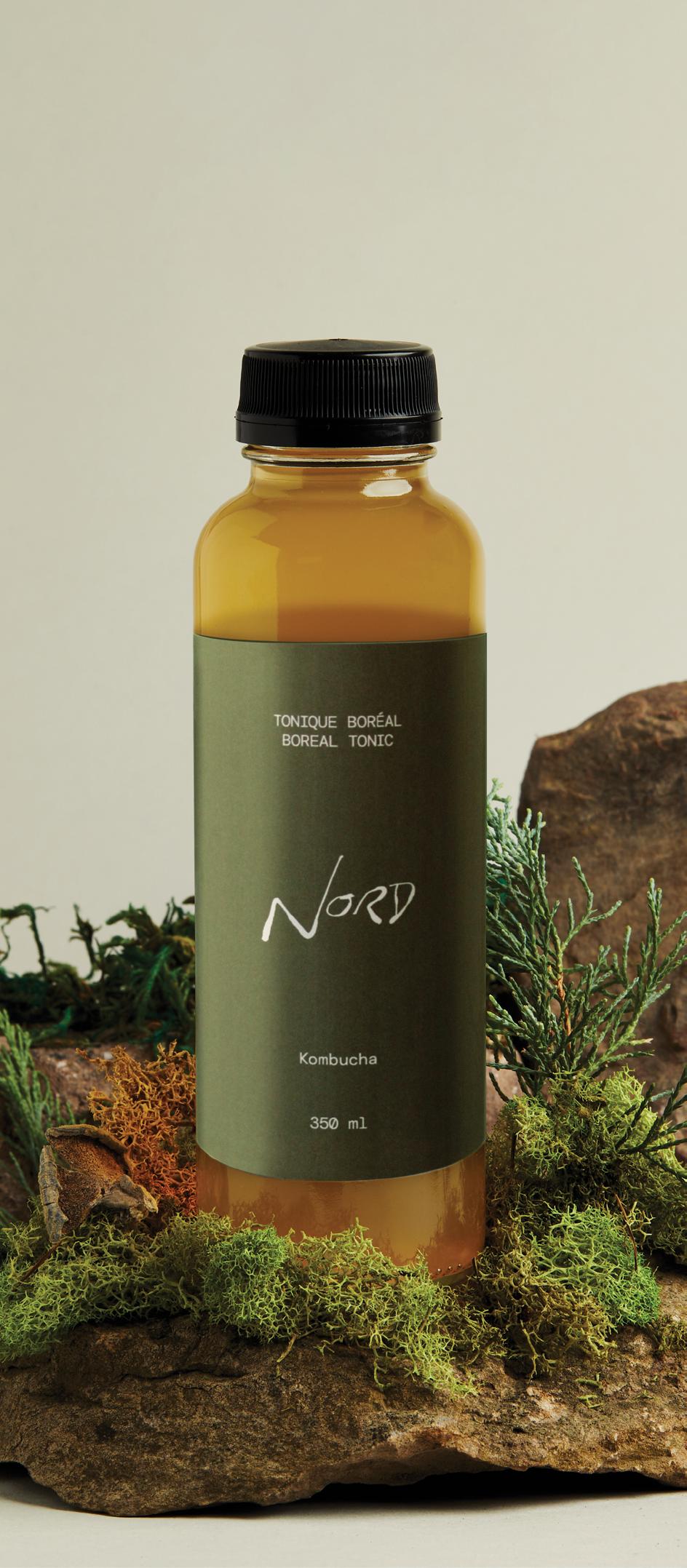
 Boreal Tonic Kombucha
Photo: © Simon Goupil
Sparkling tea, a non-alcoholic beverage reminiscent of sparkling wine
Photo: © Kim Décary
Boreal Tonic Kombucha
Photo: © Simon Goupil
Sparkling tea, a non-alcoholic beverage reminiscent of sparkling wine
Photo: © Kim Décary
Gua Sha: An Ancestral Technique
Strøm Nordic Spa has a resolutely Scandinavian DNA. The north and the boreal forest are at the heart of everything we do, so it’s only natural that our BORÉAL skin care line is born from the richness and power of local natural ingredients.

However, our desire to offer you the best care and practices isn’t limited to a single territory, a single culture, or a single tradition. All over the world, people are adopting beauty and wellness routines to feel good in body and mind. And while new, innovative techniques are sometimes the basis of these rituals, they are also often rooted in centuries-old gestures and knowledge passed down from generation to generation.
For this addition to our skin care line, we focused on a practice of traditional Chinese medicine: gua sha. To learn a little more about this subject, we spoke with Léa Bégin, the founder of Minra, with whom Strøm is collaborating for this new integration, as well as Phiane Duquet, a world champion in massage therapy and a specialist in gua sha massage, to whom the ancestral heritage has been passed down by her family.
Here is gua sha, in 10 points.
More than a facial care ritual, gua sha is traditionally used on a daily basis, all over the body. “For example, it is used to relieve back pain and headaches, to relax a tight jaw, or to reduce excess body heat, according to the application in traditional Chinese medicine,” explains Phiane Duquet.
4. THE INTEGRATION INTO SKIN CARE PRACTICES
Because it stimulates blood circulation, gua sha is also practiced for its benefits on the skin of the face. Lymphatic drainage, redefining the oval of the face, restoring radiance to the complexion, a lifting effect, reducing fine lines and wrinkles… the benefits are numerous. Léa Bégin even speaks of the technique as a non-invasive alternative or even a complement to Botox injections or fillers.
8. AT HOME
To perform the ritual at home, a step-bystep instruction manual is provided. It is important to follow the instructions and— above all—to pay attention to how you feel. Although slight redness may appear, you must be careful not to injure the skin.
“Gua sha” literally means “scraping the pain,” Duquet continues. “The drainage effect and the activation of the blood circulation encouraged by the movement are recognized for eliminating metabolic waste and therefore help alleviate certain imbalances or soothe muscle tension.”
The object with which gua sha is practiced is a flat, angular stone, cut to adapt to the shape of the face. The materials used in its production may vary. In the case of the BORÉAL stone, it is porcelain consisting of a mixture of kaolin (for whiteness), quartz (for translucency), and feldspar (for strength). The porcelain is worked in Quebec in small quantities by Louise Bousquet, according to know-how from Limoges, France. The production process and the composition result in a matte, non-porous, strong, and durable tool that is easy to handle and grip, even when used with a treatment oil.
9. THE RIGHT PRODUCT
“According to the ancestral art of lithotherapy, the object used has different properties depending on the stone from which it is made. Consequently, gua sha would traditionally have an influence not only on people’s physical appearance, but also their emotions,” Duquet recounts. Its use in traditional Chinese medicine is therefore anchored in a holistic approach to health and wellness.
6. THE GESTURES
“It’s not the stone that does the work, but the technique,” Duquet asserts. Knowledge of acupuncture points, meridians, and certain facial reflexology principles contributes to an informed and effective gua sha practice.
7. THE IMPORTANCE OF THEOR Y
Knowing the theory behind the use also makes it possible to adopt the right gestures. For example, instead of releasing stagnant fluids that cause edema, improper gua sha use can instead promote congestion.
10. CONTINUE TO STAY INFORMED
Although gua sha is an increasingly popular practice in the West, especially for its aesthetic benefits, its roots and uses are vast. If the method interests you, we strongly encourage you to learn about the principles and history behind this ancestral wellness ritual. Knowledge from other places and times has inestimable value, and its modern application is a way of paying tribute to it.
In combination with the porcelain, an oil is used—in our case, the BORÉAL face, body, and hair ritual oil. In addition to allowing the tool to slide properly in order to produce effective movements, the combined use of a product helps nourish and hydrate the epidermis. Making the oil penetrate with a stone rather than with the fingers also allows for a better application and a longerlasting effect, confirms Bégin. Try
1. AN EVERYDAY CARE TOOL
3. THE SPIRITUAL DIMENSION
5. THE TOOL
2. THE ETYMOLOGY
the treatment now by picking up the BORÉAL porcelain for gua sha ritual.
STRØM MAGAZINE 43 HOLISTIC HEALTH
Photo: © Bianca Des Jardins
Strøm Nordic Spa
Saint-Sauveur: From a Private Home to a Large-Scale Spa
After establishing its presence on Nuns’ Island, in Mont-Saint-Hilaire and Sherbrooke, then on the banks of the St. Lawrence in Old Quebec, Strøm Nordic Spa is proud to be able to become the centre of balance for a new community by settling in the Laurentians, where the tradition of Nordic spas is already firmly established.
Indeed, it was on the edge of the Rivière à Simon that the first Nordic spa in Quebec was born in the ’60s, which would later be known as the Polar Bear’s Club. In 2022, having acquired the Polar Bear’s Club and Bagni Spa Station Santé, the spa located on the other side of the river, Strøm is proud to be able to follow in the footsteps of those who were the first to promote thermotherapy in the province. With respect for the history of the place and the values shared with the previous owners, we will continue to develop the site, where the proximity of the building and the river gives life to an exceptionally relaxing environment.
To pay tribute to this meaningful and influential place, here is its history, traced from the beginning.
44 STRØM MAGAZINE HOLISTIC HEALTH
1954
Paul Charette bought the land from a farmer in Piedmont for the sum of $350. Located on the edge of the Rivière à Simon, the land also included an inhabitable house. Charette had a second house built there near the river, where he lived. The original house was rented out. He then had a wood sauna built for his wife just above the Rivière à Simon. This sauna is still accessible today.
THE EARLY 1960S

Charette started inviting his friends, including Giovanni Ramacieri, a well-known entrepreneur and designer, to come and enjoy the sauna and the Rivière à Simon. Men (women would be admitted later) met up there with friends, often on Saturdays at the end of the day, after skiing. When the river froze over, they even drilled a hole in the ice to immerse themselves.
THE WOOD SAUNA
At the time, the wood sauna, in addition to a fireplace, contained a stainless steel barrel and a heat exchanger containing water that propelled steam. Since humidity conducts heat, that made it warmer than a traditional dry sauna, which does not go above 90°C. In addition to its heating capacity, the advantage of this sauna is that it is located very close to the river, which facilitates the hot-cold cycle.
The Rivière à Simon
STRØM MAGAZINE 45 HOLISTIC HEALTH
Photo: © Bianca Des Jardins
FORMER NAME
At the time, people didn’t go to the “spa,” but to the “sauna.” There was no other facility, and the friends invited by Charette got changed in the cellar upon arrival, as one would do in a private house. The place was unknown to the public: new visitors were brought and referred by existing members.
THE 1980S
Charette sold the place to Ramacieri, who would little by little give it a more “commercial” vocation. The sauna would become accessible on Fridays and Sundays as well. Gradually, visits became paid. “Members” were charged $3 or $5 per visit, or $25 per year for a “membership.” The place still had no name, and the membership fees were used to cover the costs related to the maintenance of the sauna. It was reminiscent of a private club that was only frequented in the autumn and winter, so Ramacieri named the place the “Polar Bear’s Club.”
1986

The spa was purchased by Robert Larose, one of the members. He added opening days to the schedule. Two decades of major changes followed: it went from one tub and one sauna to seven tubs and three saunas. At that point, membership cost a few hundred dollars per year.
 The wood sauna following the fire of 1993
Photo: Courtesy of Spiro Trent
View of the old reception in 1994
The wood sauna following the fire of 1993
Photo: Courtesy of Spiro Trent
View of the old reception in 1994
46 STRØM MAGAZINE HOLISTIC HEALTH
Photo: Courtesy of Spiro Trent
OCTOBER 6, 1993
The wood sauna was the victim of a fire. Larose took advantage of the repair of the sauna to carry out a major expansion of the spa and a refurbishment of the facilities. Buildings were added, as well as new services and attractions.
JUNE 1994
A permit to build a walkway from the spa reception to the large terrace was obtained, as well as a permit to destroy the house built by Charette at the time and erect in its place the building housing the steam bath, changing rooms, and massage therapy rooms. In the years that followed, rooms intended for rental were also added.
SEPTEMBER 2008
The spa was sold to Dominique Bock and François Carrier. In the decade that followed, major redevelopment and modernization work would take place, including the addition of a new reception, the renovation of the saunas (including the original wood sauna), the addition of massage therapy rooms, and the opening of a bistro, which would later be renamed Chez Fabrice in honour of Fabrice Coutanceau, who had operated it for many years.
 Recent view of the site before its acquisition by Strøm Nordic Spa
Photo: © Polar Bear’s Club
Recent view of the site before its acquisition by Strøm Nordic Spa
Photo: © Polar Bear’s Club
We would like to thank Caroline Richer La Flèche and Derek Russell Murray for their generous contributions to this article.
First phase of updates: addition of experiences, services, culinary offerings, and the iconic Strøm design
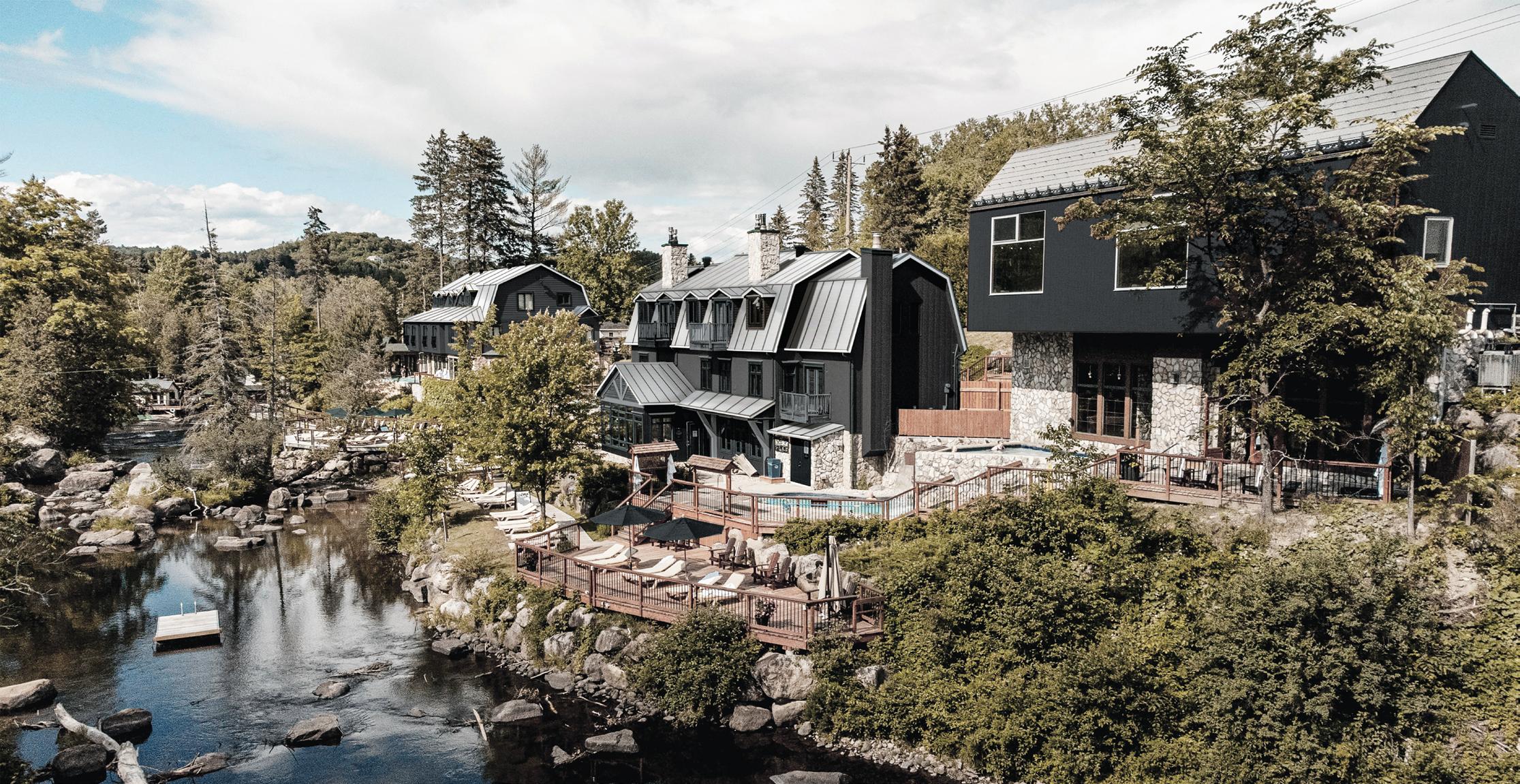
2025
Second phase of updates: structural transformation
LASTING BENEFITS
Unlike the practice of the thermal experience that is widespread these days, early members often visited the sauna, but didn’t stay there for many hours. They enjoyed three or four saunariver cycles lasting 20 to 30 minutes each, then left. The benefits reported by the first members are the same as those for which the thermal experience is practiced today: the effectiveness of the hot-cold alternation on physical wellbeing, muscle therapy, relaxation, and time for yourself. At the time, the word going around was that the endorphins provided by the ritual could be felt between the second and third cycle.
Some members who visited the place in its early days are still customers of the spa today, preferring the original wood sauna to the other facilities.
2022
Acquisition of the Polar Bear’s Club by Strøm Nordic Spa
2023
Overview of the modernization of the site following its acquisition by Strøm Nordic Spa
Photo: © Strøm Nordic Spa
The original sauna, now restored
Photo: © Bianca Des Jardins
48 STRØM MAGAZINE
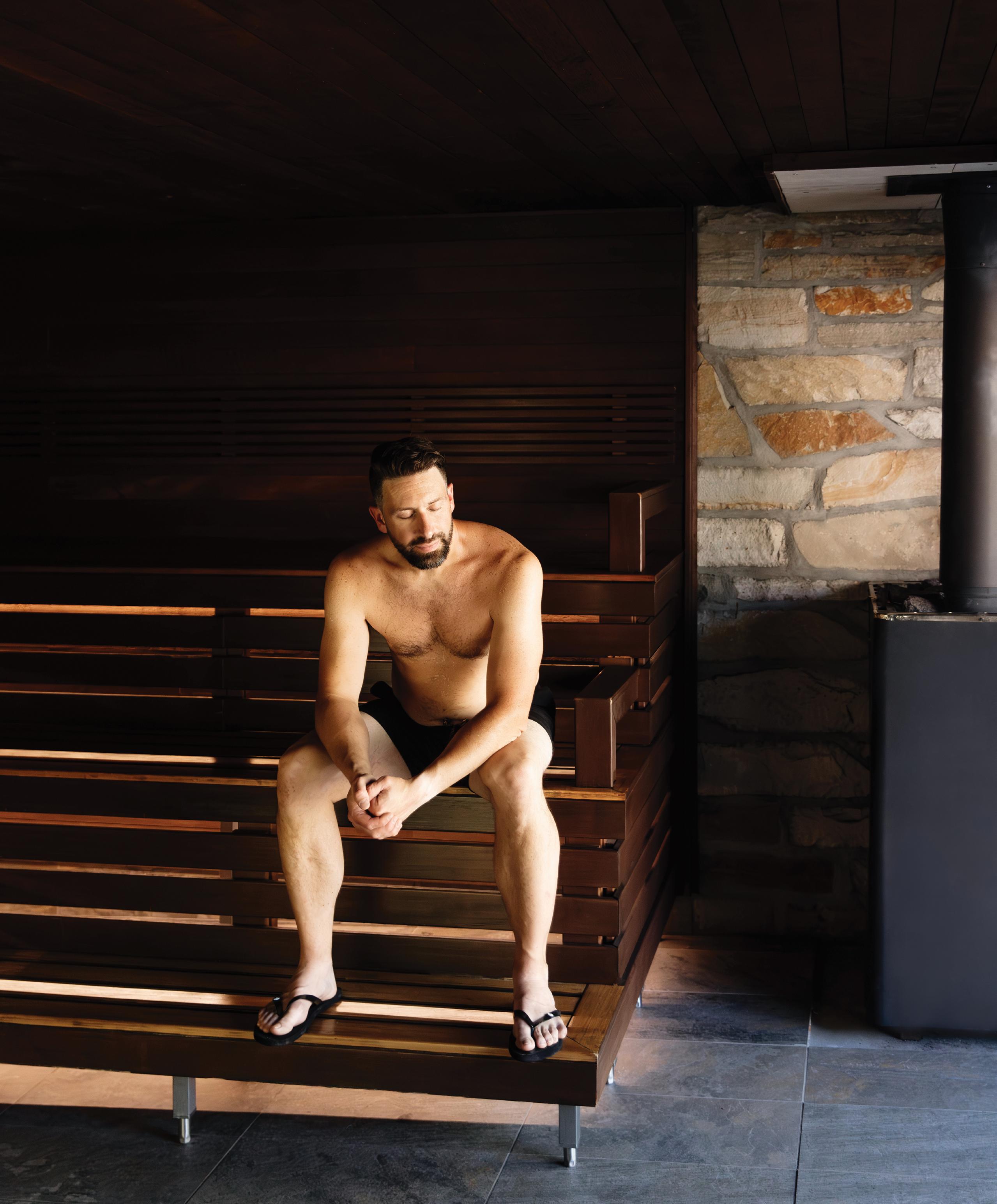
Experience the power of the boreal forest

Moisturizing Cream
SENSITIVE SKIN
Key active ingredients
Hawthorn • Quebec black spruce • Vitamin E
•
Instructions for use
Apply cream to perfectly clean skin. Massage gently until completely absorbed.
For daily use in the morning and/or evening
Visit stromspa.com to discover the full line.
Photo: © Bianca Des Jardins



You ensure balance around you; let us be yours for a moment
Photo: © Maxime Brouillet




OPENING FALL 2023 HOTELQDM.CA 1 844 494-2494 Embark on a new hotel experience. Your year-round getaway at the heart of Magog. Enhance your experience with our pre-opening package.
How about inviting well-being to the workplace?

Let's work together for healthy workplaces.

w w w . g r o u p e e n t r e p r i s e s e n s a n t e . c o m
Recognition at Work: Creator of Natural Momentum
By Julie Tremblay-Potvin, co-founder and president of De Saison — Art de vivre et de travailler
The need for recognition is a basic human need. It is related to our need for belonging—that is, to exist with others. This is why we naturally seek to be recognized or considered by the members of the various social groups to which we belong: in our family, in our social circles, and—of course—at work.
Indeed, the simple “feeling” of being seen and heard for a good achievement, a comment in a meeting, or who we are (our humour, strategic mind, listening ability, know-how, or uniqueness) can make us very happy. It also contributes to our feeling of esteem, reassures us, and gives meaning to our affiliation. Above all, it makes us want to continue being ourselves and making a difference!
In this rather individualistic era, we might be tempted to believe that we are above the need for recognition and capable of being enough for ourselves and recognizing ourselves. And yet, humans will forever and always be social beings.
Feeling recognized and recognizing the people around us in return means thinking: “We’re interconnected, we support each other, and we have a beneficial effect on each other.” The feeling of psychological security allows you to rest and think a little less about yourself and a little more about others. And that is what has allowed the human race to build the world as we know it today.
MORE THAN SAYING THANK YOU!
While the need for recognition is very often expressed, it’s not always easy to know how to meet it, especially at work. It’s as if it didn’t always come naturally to us. And, like anything, when it becomes an obligation and we don’t really understand what the point of it is, it’s less motivating to do it.
This issue of existential recognition is also at the heart of the discourse surrounding diversity, equity, and inclusion initiatives within organizations: an article published in the Journal of Personality and Social Psychology in June 2022 found that “diversity for business reasons (better productivity, creativity, customer service) repels candidates and employees instead of attracting them.”
RECOGNIZING OTHERS IN THE RIGHT WAY MEANS HELPING THEM THRIVE
In certain forms—but not just any— recognition can really help us increase our healthy motivation at work, which Jacques Forest, a professor at the Department of Organization and Human Resources at the Université du Québec à Montréal, describes as “the energy needed to get us moving.” What if we thought a little less about our own need for recognition and instead started offering recognition to our peers? A ripple effect could be created that way!
Now, let’s explore the types of recognition:
EXISTENTIAL RECOGNITION: FROM TRANSACTION TO RELATIONSHIP
The first step toward sincere and meaningful recognition is to bring the phenomenon of work back to the human level: people joining forces to achieve things. It’s not about individuals moving around in a place or sitting in front of a computer performing tasks.
In this spirit, recognizing the other as a fully fledged person, taking an interest in them, and appreciating them in their imperfections becomes much more important to increasing the quality of the relationship than simply recognizing the work done by that person—an approach that can reinforce the transactional nature of work.
How do we get there? By paying attention to the other person, asking questions, supporting informal exchanges, and spending time together in collaborative mode.
58 STRØM MAGAZINE WELL-BEING AT WORK
RECOGNITION OF NEEDS
Recognizing the person in their uniqueness also means agreeing to hear and recognize the needs that are specific to them, which are constantly evolving! This can have a reassuring effect and replenish their energy reserves to give them the momentum to continue.
To achieve this goal, listening, flexibility, and personalization are essential. New, flexible organizational measures, such as remote work, flexible schedules, and diversity, equity, and inclusion programs, could offer the greatest advantage in this sense. They facilitate the development of measures to better support the meeting of these needs (through work or outside of work).

And the other types of recognition?
The three other types of recognition are more conventional, but no less important. It’s worth distinguishing between them, since you can offer recognition and still wonder why your team members don’t feel fully recognized. The use of multiple types is key!
RECOGNITION OF EFFORT AND INVESTMENT
This refers to everything relating to the duration as well as the intensity of the investment or effort. It is therefore not at all outdated to recognize people’s seniority or their overtime, investment in a special project, or perseverance on a difficult file, regardless of the result.
In some cases, recognition of effort and investment can also lead people to take a little break and take care of themselves instead of constantly pushing themselves in the hope of receiving recognition.
Caution: be careful not to recognize only the “extra” effort and investment, but to recognize everyone’s effort and investment, even on a daily basis.
WELL-BEING AT WORK
RECOGNITION OF WORK PRACTICE
For its part, this type of recognition refers to the way of doing things. In other words, it’s like saying: “I watched you working, I saw your work, and I recognize the care you bring to it, the work ethic you demonstrate, and your interpersonal skills and know-how.”
For example, asking an employee to train another resource can be a sign of recognition of their work practice, as can recognizing a person’s agility, openness, or spirit of learning (and not just excellence).
RECOGNITION OF RESULTS OR THEIR IMPACT
In conclusion, this type of recognition can be very powerful, since it completes the circle of all the investment and effort made. This kind of recognition offers an instant self-esteem boost to the members of a team because it reminds them of the reason for their affiliation: accomplishing things together.
Finally, recognition is less a formal practice than a way of being and communicating. The thing to remember, therefore, is that it is necessary to give meaning to the recognition.
Then, you just need to find your style and adapt it to the needs and preferences of your collaborators, both at work and in life, in order to offer them the meaningful recognition that they really need, increase their feeling of motivation, and thereby build a human, lasting, and—above all—sincere collaborative relationship.
BALANCE DAY
Because wellness is one of its core values, Strøm Nordic Spa now offers all its employees a Balance Day. This annual day of leave allows everyone to take a moment for themselves by enjoying the thermal experience at the Strøm of their choice.
60 STRØM MAGAZINE WELL-BEING AT WORK



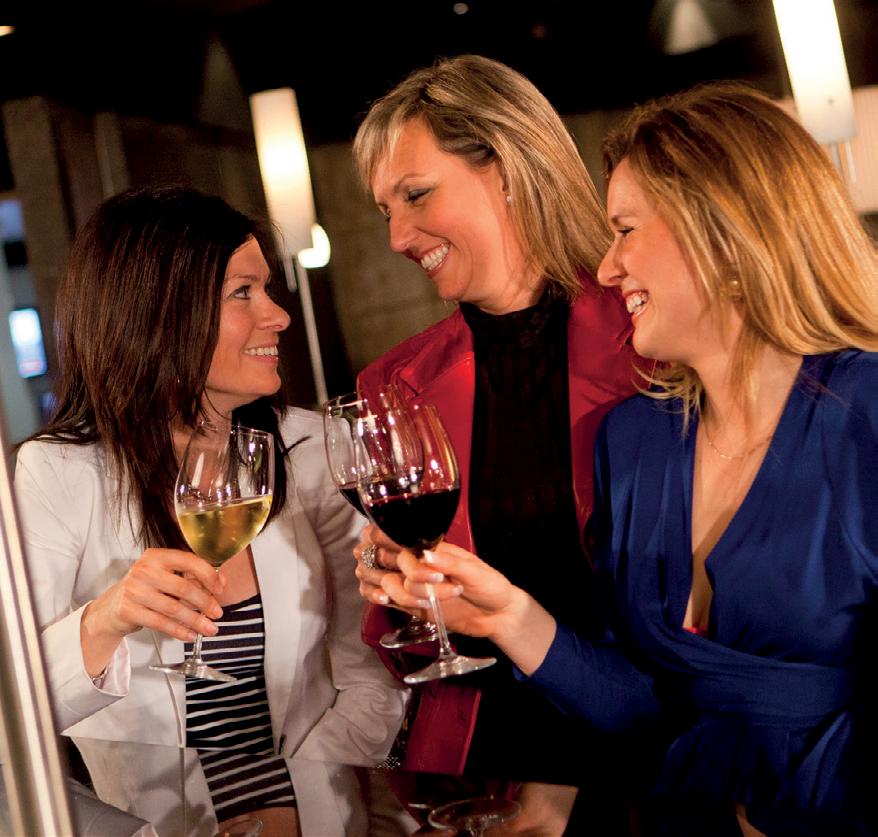


COMFORT DESIGN VALUE QUÉBEC Hôtel Sépia | 418 653-4941 | 800 463-6603 | hotelsepia.ca restaurantgalopin.com Hôtel Sépia, proud partner of Strøm nordic spa in Old Québec. Follow our offers and packages Surprisingly unique and chic hotel you must discover in Québec City
Silence
By Joannie Roberge, literary advisor and founder of La Bonne Mine
Le poids de la neige by Christian Guay-Poliquin (La
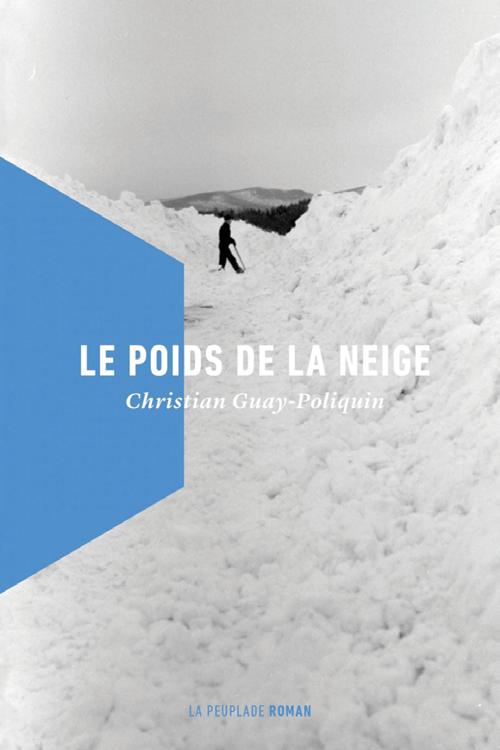 Peuplade, 2016)
Peuplade, 2016)
A power outage paralyzes the village where the narrator, whose name remains unknown, has just suffered a serious car accident. We plunge into a psychological confined space where his recovery is ensured by an old stranger: “He bends down, gets back up, and turns around as if his age were just a disguise.” The winner of the 2017 Governor General’s Award, the author grips us with his precise and captivating observations. In the urgency of the situation, mundane everyday gestures become acts of survival: tending a fire, making coffee, changing bandages. We see the days pass by through the window of the house in which the narrator is a prisoner: the variations of light, the snow piling up, the fir trees piercing the stained horizon. Looking out for a possible impromptu visit from Joseph or—better yet—Maria. This is a contemplative novel steeped in the brutality of the Nordic winter. Will the two men hold out until spring?
Quelques solitudes by
 Marianne Brisebois (Hurtubise, 2022)
Marianne Brisebois (Hurtubise, 2022)
Marianne Brisebois’ second novel addresses the grief of a long romantic relationship. Overnight, there is no more news from her friends, who seem to have chosen their side. Lili finds herself alone in her childhood bedroom, with a limited budget to rebuild her life. She decides to answer a Kijiji ad and move into a surprisingly affordable large house on Île Verte. Although painful, this isolation allows her to build her own identity, question the choices she made as a teenager, and open herself up to new realities. The same goes for her strange roommate, whose quest quickly becomes just as captivating as that of the protagonist. Flashbacks allow two plotlines to unfold in parallel and help deepen the endearing characters.
From the calm of a village after a snowstorm to the suffocating quiet of a secret, silence can be stressful or soothing. At the seaside, we readily appreciate it, but in a house on the edge of a dark forest, we dread it. In these five suggested books, silence exerts pressure on the protagonists by forcing introspection or confronting them with their inner demons, which the chaos of everyday life camouflages.
62 STRØM MAGAZINE CULTURE
À la maison
 by Myriam Vincent (Poètes de brousse, 2022)
by Myriam Vincent (Poètes de brousse, 2022)
Jessica and her husband are expecting their first child and therefore looking to move into a bigger house. Constrained by the housing crisis and the pandemic, the couple buys a house with strange architecture in the suburbs of Montreal, far from their friends. On preventive withdrawal, the narrator finds herself alone between the white walls of their new home, which—strangely—no paint is able to cover. The solitude of her pregnancy, which in no way resembles what Instagram had promised her, leaves plenty of room for distressing phenomena. Doors slam, windows seem impossible to clean, taps turn on like in horror movies. Is the house playing tricks on her? Or worse, wishing her harm? With her expert writing, Myriam Vincent tackles the mental health of young mothers and the system that trivializes their experience. This is an in-your-face novel that keeps you in suspense until the end.
Femme de Vitruve
 by Sara Lazzaroni (Leméac, 2023)
by Sara Lazzaroni (Leméac, 2023)
Simone and Nora don’t know each other, but they both earn their living by putting their charms to work for product placement. They frequent public places and social events with the aim of encouraging consumption. Their bosses exert excessive control over their weight, hair colour, and pastimes. They must constantly represent the idealized woman, a source of desire and envy. Unable to reveal the nature of their work to anyone, they live with the burden of their secrets without being able to confide. This two-voiced novel addresses the loneliness that grows behind apparent perfection once the production is over. Sara Lazzaroni’s writing sticks to the basics and cultivates the unsaid, in contrast with the artifice present in the story.
Paul à la maison
 by Michel Rabagliati (La Pastèque, 2019)
by Michel Rabagliati (La Pastèque, 2019)
The 9 th volume in the series, awarded twice at the prestigious Angoulême International Comics Festival, is darker than the previous ones, even if it makes us smile a few times. Paul ends up alone in his house in Ahuntsic, which has been drawn with precision, right down to the placement of the trees and cedar hedges. His yard is breaking down at the same pace as his life, deserted by the people he loves. His mother is sick, his wife has left him, and his daughter, whom he almost never sees anymore, tells him that she is going to live in England. The melancholy of the passing days and seasons is described with tenderness and realism. The loneliness of his daily life also leaves room for some memories of his childhood and his life as a young father. This volume, in which you can immerse yourself even without having read the previous ones, describes grief and nostalgia.
STRØM MAGAZINE 63 CULTURE
 Photo: © Bianca Des Jardins
Photo: © Bianca Des Jardins
A Nordic-inspired gourmet space from chef Raphaël Podlasiewicz and his team
Restaurant open to the public on the South Shore of Montreal
By Strøm Nordic Spa
1887, av. Bourgogne, Chambly

New
 Photo: © Bianca Des Jardins
Photo: © Bianca Des Jardins
Savoury Smoked Salmon Cake
A creation by Kevin Lafrenière, executive sous-chef of Strøm Nordic Spa restaurants
A perfect recipe for brunch, an appetizer, or even a light dinner, accompanied by some greens. Easy to make, this cake is sure to impress with its thoughtful toppings and the contrast between the freshness of the crunchy fennel, the smokiness of the salmon, and the acidity of the vinegar.
Ingredients
1 onion, finely chopped
20 mL + 100 mL sunflower oil
200 mL white wine
4 eggs
250 g flour
1 tsp baking powder
2 pinches salt
½ tsp fennel seeds, ground
250 g hot smoked salmon
Toppings
Sour cream
Fresh dill
Minced fennel
Cider vinegar
Olive oil
100 g cold smoked salmon
1 poached egg
Daisy or regular capers
Salt and pepper
Fry the onion over medium heat in 20 mL of sunflower oil for 8 to 10 minutes until slightly golden. Deglaze with 100 mL of white wine and cook until the wine evaporates. Remove from heat. Using a stand mixer fitted with the whisk attachment, mix 100 mL of sunflower oil, the eggs, and the remaining 100 mL of white wine for 2 minutes.
Add the flour in a drizzle, then the baking powder, salt, and fennel seeds, mixing at low speed.
Add the onion and coarsely crumbled smoked salmon. Mix gently. Pour the mixture into a 9x5-inch loaf pan coated beforehand with Pam-type non-stick cooking spray and bake in an oven preheated to 350°F for approximately 50 minutes. Remove from pan and let cool on a rack.
Preparation Presentation
Slice the cake delicately.
Place 1 Tbsp. of sour cream on the plate, top with dill, salt, and pepper, and position a slice of cake on top.
Add the fennel seasoned with a few drops of cider vinegar, olive oil, dill, salt, and pepper. Top with one or two slices of cold smoked salmon, a poached egg, and a few capers, to taste.
1 1 3 4 2 2 4 3 5 6
Servings 8 Preparation time 20 min. Cooking time 50 min. STRØM MAGAZINE 67 À TABLE
A Lesson from Italy
By Emiko Davies, culinary author
My two children, aged 10 and 5, grew up in this environment, often participating by cracking eggs, rolling pasta and cooking alongside me, much to my delight. Even if they aren’t always interested in eating what we make, cooking together is about the connection we have and the life skills they learn—preparing food, yes, but also learning to love food.
I’ve been living in Italy for almost two decades. I moved from Sydney, Australia, in 2005. I grew up in Australia in the ’80s and China in the ’90s with a Japanese mother who, like her own mother, often saw food like some kind of medicine. Eat something vinegary when you’re tired, and eat piping hot, grilled, spicy rice cakes to keep you warm all day if you’re cold. I got the message growing up: food nourishes you and helps you feel good.
When I began to discover Italian cuisine, especially when I started my own little family, I realized how important this relationship with food (and feeding) is to Italians. Food is their love language— I think that is maybe why I feel so at home in Italy, as I speak this language fluently.
Seeing food and drink as something joyful, something to be savoured and as an opportunity to bring people together is one of the things that I feel Italians have really turned into an art form. In Why Italians Love to Talk About Food , Elena Kostioukovitch writes, “The aroma of a simmering ragú, the bouquet of a local wine, the remembrance of a past meal: Italians discuss these details as naturally as we talk about politics or sports, and often with the same flared tempers.”
In Italy, sitting at the dinner table is about being together. From a very young age, eating together is prioritized as a social activity. At pre-school and elementary school, the children sit with their teacher and their entire class for lunch, where they all eat the exact same meal. Having dinner together as a family is important, so the children wait for their parents to get home from work before sitting down to eat. It means even young Italian children have relatively late bedtimes—often 9 p.m. on a weeknight, if not later, but the tradeoff is spending precious time together over a meal.
Food is not just fuel, and mealtimes are not just for eating. Food is an opportunity to connect with others. It is also a part of culture and identity; of family and traditions; it is a source of joy—it is not something to feel “guilty” about. Savouring a pastry and cappuccino for breakfast or a gelato in the evening while enjoying a passeggiata (leisurely stroll) during the long, hot summer months, is not only the norm, but a timehonoured ritual that everyone, no matter their age, looks forward to.
As a cookbook author and food writer, on a usual day you will find me at home in a small town in Tuscany, tinkering with recipes, cooking or photographing dishes for my recipe column or my newsletter.
Emiko and her eldest daughter in the kitchen
68 STRØM MAGAZINE À TABLE
Photo: © Emiko Davies

For us, the dinner table is also a place where I want my children to remember feeling safe and happy because we can connect with each other if we aren’t feeling relaxed. My eldest daughter has been an anxious eater since she was around 3 years old. She used to turn down playdates because the thought of eating or being offered certain foods in front of other people made her so nervous. Eating at school filled her with so much anxiety that she would sometimes fast for days on end, as I watched her rib cage grow ever more defined. She experiences all emotions most strongly in her gut, as do all of us. If the peace is disturbed, she may suddenly lose her appetite, even if I put her favourite dish in front of her.
To help her have a positive relationship with food, even when she didn’t feel like eating, I emphasized the importance of respecting the signals her body was sending her about her own hunger or appetite. I also wanted to make sure she still viewed food as something enjoyable, accessible, and familiar. Every so often, just for fun, we would make pasta, pizza, cakes, or gelato at home, and even film recipe videos together. It didn’t even matter if she ate the food we made or not, because we were just exploring. I would let her play with flour or dried beans and legumes—she would make drawings out of them, run her hands through them. I brought her to the market with me and we would have fun naming the fruit and vegetables, or we would go pick wild berries, visit friends’ farms and watch goats getting milked, bees busy in their hives, mozzarella being made or collect fresh eggs. Living in Italy has made all of this so much easier for us, and she has grown out of her anxiety around food over the years. She now gladly enjoys eating meals with us as well as her friends and schoolmates, ordering from trattoria (small Italian restaurant) menus with ease and poise.
 Emiko’s two daughters in the kitchen
Photo: © Emiko Davies
Emiko’s two daughters in the kitchen
Photo: © Emiko Davies
70 STRØM MAGAZINE
[…] I believe it’s so important to help children, especially girls, understand that food can be an immense source of joy and connection […]


 San Miniato, where Emiko lives, in Tuscany
Photo: © Sarah Lamarche
Emiko in her new workshop/boutique, Enoteca Marilu
Photo: © Sofie Delauw
San Miniato, where Emiko lives, in Tuscany
Photo: © Sarah Lamarche
Emiko in her new workshop/boutique, Enoteca Marilu
Photo: © Sofie Delauw
When her sister was born a few years later, this approach to food came naturally. My youngest has been overweight from a very young age. She is active, healthy, and eats nutritious, homemade food, but she just has a larger body—like I did when I was a child. As with my eldest daughter, I believe it’s so important to help children, especially girls, understand that food can be an immense source of joy and connection instead of something to be feared or restricted. As a result, we cooked together; she has always been naturally drawn to helping me in the kitchen, just like I did with my mother when I was a child.
Whenever I shared content of my bubbly, smiley girl making pasta like an expert, helping her sister make panna cotta, rolling out homemade puff pastry or enjoying minestrone, messages would come flooding in—especially from people who once looked like my daughter or who had children with bodies similar to hers. Strangers have told me how much their children love to watch my daughters cook, or that they wished their parents had not demonized food when they were growing up.
Feeding people, especially your own loved ones, is not easy. It can be difficult for us as adults (especially if you’ve listened to anything that diet culture tells us) to listen to and trust our own bodies, let alone for parents to trust their children’s bodies (they are usually more intuitive than we realize). Supporting my daughter in her relationship with her body can sometimes feel like swimming against the current, because society doesn’t normalize or celebrate the fact that all bodies are beautiful and that they can even change (often dramatically) over different phases of our lives. But I believe the best support I can give my children—both of them—is the same support I received growing up: the knowledge that they and their bodies will always be loved unconditionally, no matter what size or shape they may be (or become in the future). I need them to know they are enough, just the way they are.
I have learned that all I want for my family, or anyone that I feed, is for them to feel comfortable, safe, and loved at the table. I trust their appetites, I trust them to listen to their own bodies and I respect their preferences (we all have them). I feel very grateful that we live in a culture where a positive outlook on food is celebrated at every meal. This—appreciating where food comes from and adopting a philosophy where meals are about being together and feeling loved, rather than demonizing, forcing or restricting food—is a path to a positive way of life. It empowers me to raise two girls who love themselves, who are confident, respectful of their own bodies and who unapologetically pursue joy. Feeling good together at the table is just as important, if not more, as the food itself.
À TABLE STRØM MAGAZINE 73
The Trades of Wine, Continued
By Stéphanie Dupuy, sommelière
In the last edition of the magazine, I talked about two trades practiced by few people and unknown to many of us. These trades, often manual and steeped in a long tradition, are fascinating for their uniqueness, but also for the extraordinary knowledge and know-how that they require to be practiced. Here is the continuation of this brief foray into the world of the unsuspected trades of wine.
STAVE MILLER
The trade of cooper was one of our discoveries in the previous article. To manufacture their barrels, the cooper works with oak already packaged into high-quality planks, free of imperfections. The painstaking task of transforming an oak into blocks, then into staves (planks that will be assembled to form a barrel), is that of the stave miller.
The oak used in stave milling and cooperage comes from various large forests around the world: eastern Europe, the United States, and—of course—France. The forests of Tronçais, Cîteaux, and Darney are home to the cream of the crop of French oak intended for barrel manufacturing. These trees represent only 1% of the French wood marketed annually and are therefore a rarity. Very slender, they usually measure more than 25 metres in height and lack branches on most of their trunk. They grow very slowly (around 5 mm in diameter per year), which gives the wood grain the perfect density for a barrel. With such a slow growth rate, oaks are therefore pampered by several generations for 150 to 200 years. This means that foresters will be harvesting oaks this year whose acorns germinated between 1823 and 1873!
When the tree is considered mature enough, it is sold, often at auctions. The entire trunk, from the base to the first branches, will be used to make staves. Upon arriving at the processing site, the stave mill, the oak will be cut into one-metre blocks, then split in two lengthwise to respect the grain direction of the tree and guarantee the airtightness of the barrel. Each half of the block will then be split again into approximately five sections, which will be worked into two or three staves. Finally, the staves will be placed outside, at the mercy of the wind and weather for a period of one and a half to two and a half years before being sent to the cooperage. Only 30% of the oak will be used by the stave miller. The head, foot, bark, sapwood, and core will be used for other purposes, such as producing shavings, being sent to the sawmill for framework, or manufacturing furniture. Despite all that, an oak will produce eight to 15 barrels, depending on its size.
NURSERY OWNER
In the 19 th century, the phylloxera, a half-millimetre insect related to the aphid, was accidentally introduced to France through the importation of American vine plants. Originally from Mississippi, this insect attacks the root system of the vine and completely kills it in just three years. The situation quickly got out of control and became catastrophic in France, then Europe, and soon almost everywhere on the planet. Millions of square kilometres of vines were lost. It was from this devastation and the need to find a solution that the trade of nursery owner was born.
Several unsuccessful methods were implemented to combat the phylloxera, but since it was observed that American vines ( Vitis labrusca) were not affected by the insect, the option of grafting became necessary. The technique was simple: a graft from the desired Vitis vinifera species (chardonnay, pinot noir, cabernet sauvignon, etc.), which would produce leaves and fruit, was grafted onto an American vine plant called a rootstock.
In the winter, when the vine is dormant and the sap is no longer circulating, the shoots—or stems of the rootstock vine—are cut to approximately 30 cm in length. The shoots of the graft are also cut, but to only a few centimetres, taking care to keep an emerging bud on the cutting. In the spring, the two pieces are assembled by a worker using a pedal-operated cutting machine that removes a piece from the rootstock and prunes the graft so that the two intertwine perfectly. Think of two puzzle pieces that fit together. Thus assembled, the shoots are stored in cool places to promote stratification. In May, the shoots—still without roots—are planted. Maintenance, irrigation, treatment… the right care from the nursery owner is required so that the shoots develop until they become a vine plant. Around November, when the vine falls dormant again, the plants are uprooted. The root system as well as the quality of the graft are checked, and the vine is placed in cold storage, ready to be delivered to the winemaker.
74 STRØM MAGAZINE À TABLE
There are a few regions in the world that have been spared from the phylloxera. This is the case with Chile, protected by the Andean Cordillera, island vineyards such as the Canary Islands, or vineyards such as Barolo and Barbaresco, in Italy, whose sandy soils do not allow the insect to proliferate. Grape varieties grown in these terroirs are said to be franc de pied. Otherwise, today, almost all the vines in Europe are grafted. Although unknown to most wine consumers, the trade of nursery owner is nevertheless absolutely essential.
Embrace the aperitivo ritual with Amermelade, Quebec’s first bitter apéritif!
NATHALIE BONHOMME, VALENCIA, EL BONHOMME 2021
11157185 – $19.40
Of Quebec origin, Nathalie Bonhomme produces wine in the hot and sunny region of Valencia in Spain. This vintage is a blend of monastrell (mourvèdre) and cabernet sauvignon. Plenty of fruit can be found here in a rich and fleshy whole, without lacking freshness.
FALDAS DA SERRA, DÃO, MAIAS 2021, ORGANIC 14070472 – $17.35
Here is a typically Portuguese wine with a blend of indigenous grape varieties: jaen, alfrocheiro, touriga nacional, and tinta roriz. It is produced by the Lourenço family, who are highly respected in the Dão region. This wine, offering flavours of ripe red and black fruits with notes of spices, is the perfect pairing for a dish of pasta with sausage or grilled pork chops.


CATHERINE & PIERRE BRETON, VOUVRAY, ÉPAULÉ JETÉ 2021, ORGANIC, NATURAL 12103411 – $25.95

Catherine and Pierre Breton offer a charming 100%-chenin blanc vintage here. Notes of yellow apple, pear, and honey can be found here, all with an invigorating freshness supported by a pleasant bitterness that adds texture and whets the appetite. An ideal wine for an aperitif with a baguette and some camembert.
In a bottle of Amermelade, you will find the history of classic italian aperitivi and a deliciously fresh wind of change with local flavours such as sweet gale and sea buckthorn.
Discover Les Spiritueux Iberville products at all SAQ locations and Strøm Nordic Spa restaurants.

À TABLE

Five Havens for Contemplation in Nature
For the first time, we are proud to be able to introduce you to a fifth Strøm Nordic Spa haven. This is in addition to the four other establishments, which, for several years, have welcomed you for a unique moment of relaxation.
Discover them all throughout these pages, as they quietly adorn themselves in their winter colours.
 Photo: © Bianca Des Jardins
Photo: © Polar Bear’s Club
Photo: © Bianca Des Jardins
Photo: © Polar Bear’s Club
FACILITIES
1. The Rivière à Simon
2. A dry sauna with salt blocks
SAINT-SAUVEUR
FACILITIES
1. In the winter, the site spreading out over several levels
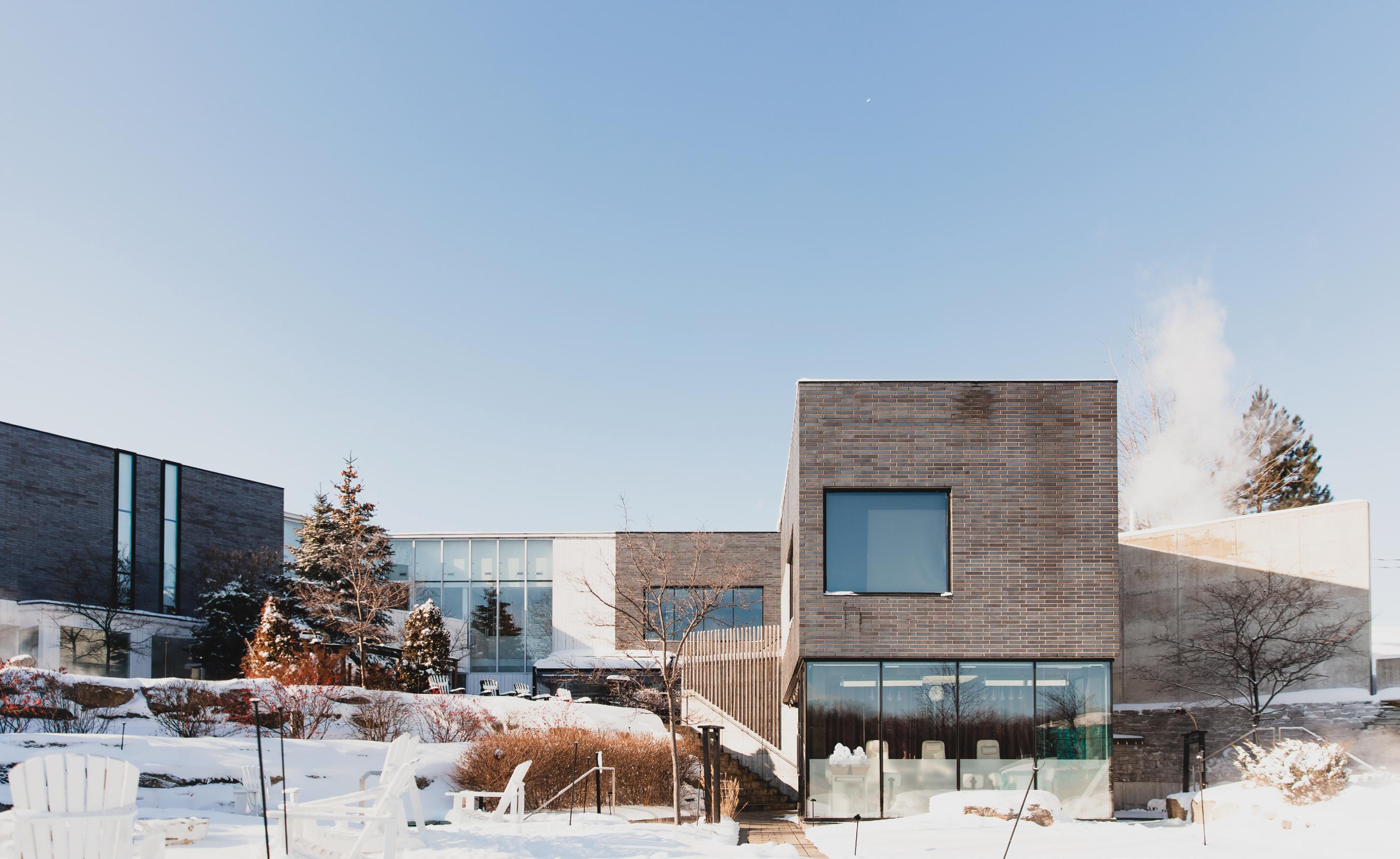
78 STRØM MAGAZINE
FACILITIES
1. Various pools and relaxation areas seen from above
2. A Finnish sauna


NUNS’ ISLAND
79 STRØM MAGAZINE
Photos: © Bianca Des Jardins
FACILITIES
 1. An outdoor hot tub
2. The temperate swimming pool
MONT-SAINT-HILAIRE
1. An outdoor hot tub
2. The temperate swimming pool
MONT-SAINT-HILAIRE
80 STRØM MAGAZINE
Photos: © Bianca Des Jardins

FACILITIES
 1. Resting place in the Strøm River
1. Resting place in the Strøm River
OLD QUEBEC
2. One of the entrances to the Strøm River
82 STRØM MAGAZINE
Photos: © Olivier Staub


FACILITIES
84 STRØM MAGAZINE
1. A Finnish sauna with a view of the Magog River
FACILITIES
1. The building along the shore

2. One of the spa’s many hot tubs

SHERBROOKE
85 STRØM MAGAZINE
Photos: © Adrien Williams
Discovering Local Businesses
CACTUS EN LIGNE

Add some life to your spaces with Cactus en ligne! We have a wide selection of cactuses, succulents, hoyas, and tropical plants in stock.

Enjoy a 15% discount online with code STROM15. cactusenligne.ca
RICHPORTER
LIGHTING
Create a peaceful and harmonious workspace with humancentric lighting (HCL). Discover the transformative power of HCL: improve morale, energy, and concentration by simulating natural light. Join other forward-thinking companies adopting a positive work environment.

BÉTON ARCHITECTURAL JOHNSTONE
High-end architectural concrete and terrazzo prefabricated right here in Quebec. Johnstone specializes in the artisanal production of unique pieces: tables, vanities, basins, counters, furniture, tiles, and more.

info@johnstone.work
579 380-9189
@betonjohnstone betonjohnstone.com
Consult our experts for your personalized lighting plan that will enhance your space and your well-being.
Strøm Campus Conference Room 514 395-3795 I 1-877-885-6945
@richporterlighting richporterlighting.com
86 IN PARTNERSHIP
Discovering Local Activities
POINTE-À-CALLIÈRE: MONTREAL ARCHAEOLOGY AND HISTORY COMPLEX
Pointe-à-Callière, the birthplace of Montreal, is now the largest archaeology museum in Canada and the most visited history museum in Montreal.
514 872-9150
350, place Royale, Old Montreal, QC H2Y 3Y5 pacmusee.qc.ca
PROMENADE WELLINGTON: A UNIQUE DESTINATION 10 MINUTES FROM NUNS’ ISLAND
The Well is more than just a street; it’s a dynamic neighbourhood that takes you on a journey thanks to its proximity to the riverbanks and its abundant offerings of shops, restaurants, and cafes.
514 766-6437


Métro De l’Église (Montreal) promenadewellington.com
LE PETIT CHAMPLAIN: A PICTURESQUE NEIGHBOURHOOD WITH A LOCAL FLAVOUR IN QUEBEC CITY

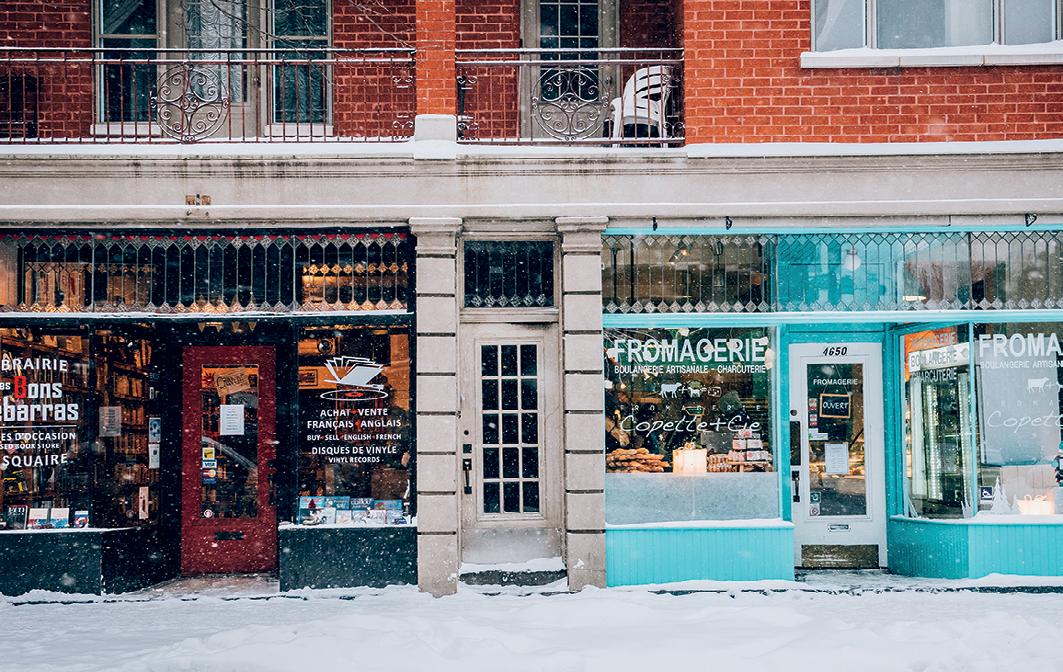
Roam the cobblestone streets and meet welcoming merchants, local artisans, creative designers, and passionate restaurateurs.
quartierpetitchamplain.com

SKI SAINT-BRUNO: THE SKIER CREATOR
SSB is THE family place to learn to ski and for intermediate-level skiers and boarders who want to improve their technique. Après-ski, events, mascots… all just two steps from the house!
15% off your daily ticket with code STROM skisaintbruno.ca

IN PARTNERSHIP 87

LIVE IN CON NEX ION At the heart of the Pointe Nord neighbourhood, discover Evolo NEX offering an unprecedented connection between the city, nature and the river. o Direct access to the river o Steps away from the REM station o Garden courtyard with an outdoor swimming pool o Nordic spa o Collaborative workspace o Welcoming home with noble materials combining luxury and comfort 2024 delivery Be at the forefront! nexcondos.ca NUNS’ ISLAND Sales office 121, Chemin de la Pointe Nord Nuns’ Island (Quebec) H3E 0C5 514-761-1333


Change the perception of working out *By appointment only To request a trial, please contact the nearest gym, or visit energiecardio com No cash value/No exchange Limit one free trial per person ENJOY A * FREE Free training | Private training | Various group classes WORKOUT TRIAL + AN INBODY



avril.ca Le fortifiant Smoothie Available at our bistros | Recipe on avril.ca BROSSARD | GRANBY | LAVAL | LÉVIS | LONGUEUIL | MAGOG | MONTRÉAL QUÉBEC | REPENTIGNY (FALL 2023) | SAINT-BRUNO | SAINTE-FOY | SHERBROOKE



















 Guillaume Lemoine President
Photo: © Bianca Des Jardins
A WORD FROM THE PRESIDENT
Guillaume Lemoine President
Photo: © Bianca Des Jardins
A WORD FROM THE PRESIDENT

 Le Monastère des Augustines in Quebec City
Le Monastère des Augustines in Quebec City
 Photo: © Eva-Maude TC
Photo: © Eva-Maude TC










 Photo: © Jp Valery
Photo: © Jp Valery











 Strøm Nordic Spa Sherbrooke
Photo: © Adrien Williams
Strøm Nordic Spa Sherbrooke
Photo: © Adrien Williams






















 Boreal Tonic Kombucha
Photo: © Simon Goupil
Sparkling tea, a non-alcoholic beverage reminiscent of sparkling wine
Photo: © Kim Décary
Boreal Tonic Kombucha
Photo: © Simon Goupil
Sparkling tea, a non-alcoholic beverage reminiscent of sparkling wine
Photo: © Kim Décary



 The wood sauna following the fire of 1993
Photo: Courtesy of Spiro Trent
View of the old reception in 1994
The wood sauna following the fire of 1993
Photo: Courtesy of Spiro Trent
View of the old reception in 1994
 Recent view of the site before its acquisition by Strøm Nordic Spa
Photo: © Polar Bear’s Club
Recent view of the site before its acquisition by Strøm Nordic Spa
Photo: © Polar Bear’s Club


















 Peuplade, 2016)
Peuplade, 2016)
 Marianne Brisebois (Hurtubise, 2022)
Marianne Brisebois (Hurtubise, 2022)
 by Myriam Vincent (Poètes de brousse, 2022)
by Myriam Vincent (Poètes de brousse, 2022)
 by Sara Lazzaroni (Leméac, 2023)
by Sara Lazzaroni (Leméac, 2023)
 by Michel Rabagliati (La Pastèque, 2019)
by Michel Rabagliati (La Pastèque, 2019)
 Photo: © Bianca Des Jardins
Photo: © Bianca Des Jardins

 Photo: © Bianca Des Jardins
Photo: © Bianca Des Jardins

 Emiko’s two daughters in the kitchen
Photo: © Emiko Davies
Emiko’s two daughters in the kitchen
Photo: © Emiko Davies


 San Miniato, where Emiko lives, in Tuscany
Photo: © Sarah Lamarche
Emiko in her new workshop/boutique, Enoteca Marilu
Photo: © Sofie Delauw
San Miniato, where Emiko lives, in Tuscany
Photo: © Sarah Lamarche
Emiko in her new workshop/boutique, Enoteca Marilu
Photo: © Sofie Delauw





 Photo: © Bianca Des Jardins
Photo: © Polar Bear’s Club
Photo: © Bianca Des Jardins
Photo: © Polar Bear’s Club



 1. An outdoor hot tub
2. The temperate swimming pool
MONT-SAINT-HILAIRE
1. An outdoor hot tub
2. The temperate swimming pool
MONT-SAINT-HILAIRE

 1. Resting place in the Strøm River
1. Resting place in the Strøm River



















